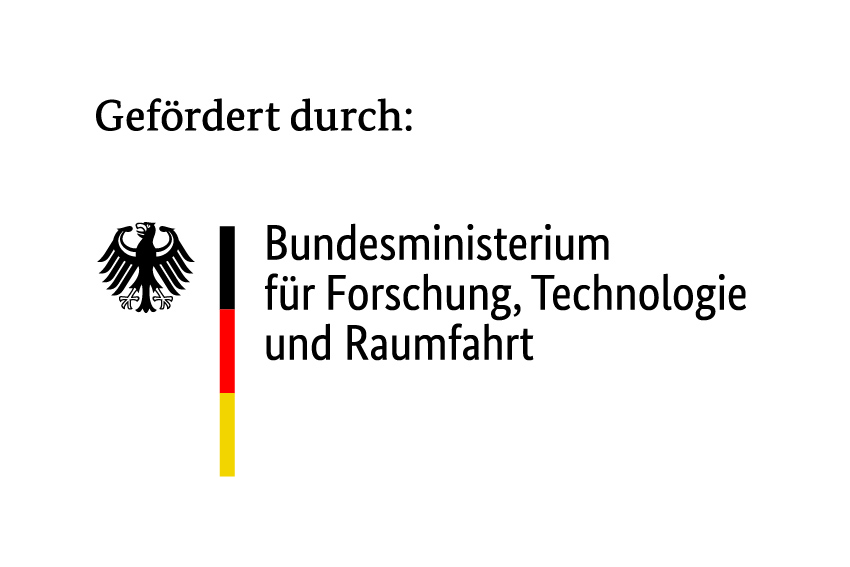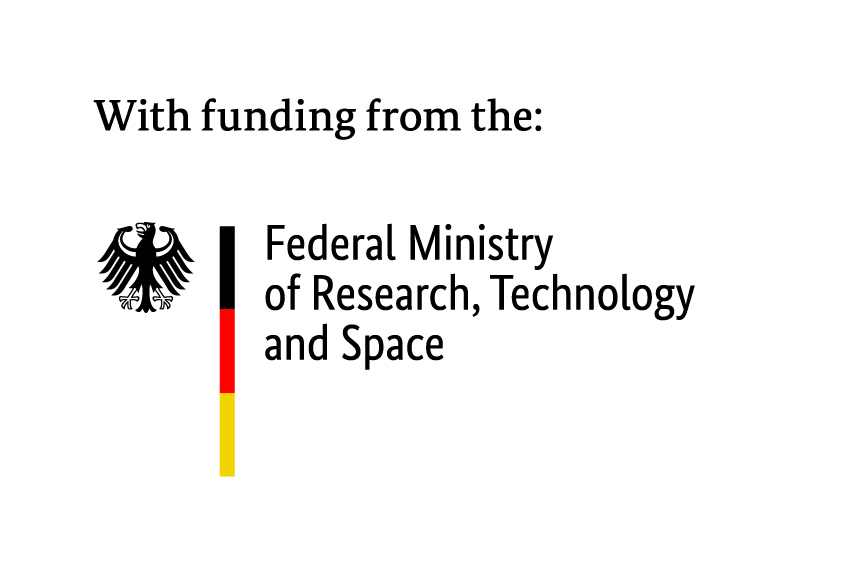Publikationen
An dieser Stelle finden Sie Publikationen, die mit dem Förderschwerpunkt in Verbindung stehen.
SFCP I Policy Brief

Zentrale Empfehlungen für eine nachhaltige Finanzwirtschaft
Die Transformation zur klimaneutralen und nachhaltigen Wirtschaft stellt Deutschland vor große Herausforderungen und erfordert erhebliche Investitionen vom Staat und der Privatwirtschaft. Dabei steht nachhaltige Finanzwirtschaft (Sustainable Finance) zur Unterstützung der Transformation im Fokus. Dieser Policy Brief fasst Forschungsergebnisse der BMFTR-Fördermaßnahme „Klimaschutz und Finanzwirtschaft“ zusammen, ergänzt diese um aktuelle Diskussionen und leitet konkrete politische Handlungs-Empfehlungen ab. Im Mittelpunkt stehen die folgenden drei Herausforderungen: Transformationsfinanzierung, Berichterstattung und Sanierung von Gebäuden.
- Veröffentlichungsdatum: 03.07.2025
- Autor:innen: Prof. Dr. Alexander Bassen, Prof. Dr. Timo Busch, Prof. Dr. Kerstin Lopatta, Hendrik Brosche, René Wagner, Henrik Ohlsen, Lisa Enders, Patrick Weltin
- Link zum PDF-Dokument
SFCP I Synthesezwischenbericht 2024

Synthese-Zwischenbericht 2024: Aktuelle Entwicklungen in der Klima- und Finanzforschung
Der SFCP Synthese-Zwischenbericht 2024 verknüpft die bisherigen Forschungsergebnisse der KlimFi Projekte mit nationalen und internationalen Entwicklungen in der Klimawandel- und (Klima-) Finanzforschung und stellt übergreifende Schlussfolgerungen sowie Handlungsempfehlungen für relevante Interessengruppen aus Wissenschaft, Politik und Finanzwirtschaft bereit. In drei Kapiteln (Nachhaltigkeit im Mittelstand, Transformationsfinanzierung & Impact Investing) werden zentrale Sustainable Finance Themenfelder diskutiert, der Stand der Forschung, Handlungsbedarf verschiedener Akteur:innen sowie der Beitrag der Wissenschaft präsentiert: Die Forschung zeigt eine gute Entwicklung der Sustainable Finance Landschaft in Deutschland und der EU, welche jedoch vor einigen Herausforderungen steht. Um vergleichbare und einfachere Berichterstattung sowie effektive nachhaltige Finanzinstrumente zu ermöglichen, besteht ein dringender Bedarf nach mehr Harmonisierung der Regulatorik. Darüber hinaus sollte die Politik durch zielgerichtete Maßnahmen eine aktivere Teilnahme von KMU und Kleinanleger:innen am Transformationsprozess fördern. Letztlich ist der Transfer des wissenschaftlichen Diskurses in die Praxis entscheidend, um konkrete Veränderungen in der Realwirtschaft zu erzielen und eine klimaneutrale Gesellschaft zu schaffen.
- Veröffentlichungsdatum: 2024
- SFCP-Autor:innen: Prof. Dr. Alexander Bassen, Prof. Dr. Timo Busch, Prof. Dr. Kerstin Lopatta, Hendrik Brosche, René Wagner, Svenja Scherer, Henrik Ohlsen, Lisa Enders, Patrick Weltin
- KlimFi-Autor:innen: Prof. Dr. Christina E. Bannier & Sebastian Rink I Andreas Schmitt, Benedikte Sandbaek, Joachim Jörg, & Prof. Dr. Tobias Popovic I Dr. Gunnar Gutsche, Lisa Knob & Prof. Dr. Marco Wilkens
- Link zum PDF-Dokument
KlimFi I Infoflyer

KlimFi-Infoflyer: Forschung zu nachhaltiger Finanzwirtschaft
Der KlimFi-Infoflyer bietet einen Überblick über die Fördermaßnahme KlimFi, das Begleitvorhaben SFCP und alle weiteren KlimFi-Forschungsprojekte. Forschungsinhalte und erste Ergebnisse werden pro Forschungsprojekt aufgezeigt.
- Veröffentlichungsdatum: 2024
- SFCP-Autor:innen: Prof. Dr. Alexander Bassen, Prof. Dr. Timo Busch, Prof. Dr. Kerstin Lopatta, Hendrik Brosche, René Wagner, Svenja Scherer, Henrik Ohlsen, Lisa Enders, Patrick Weltin
- Link zum PDF-Dokument
Projektposter
ClimFiSoc I Die Realpolitik der Klimafinanzierung
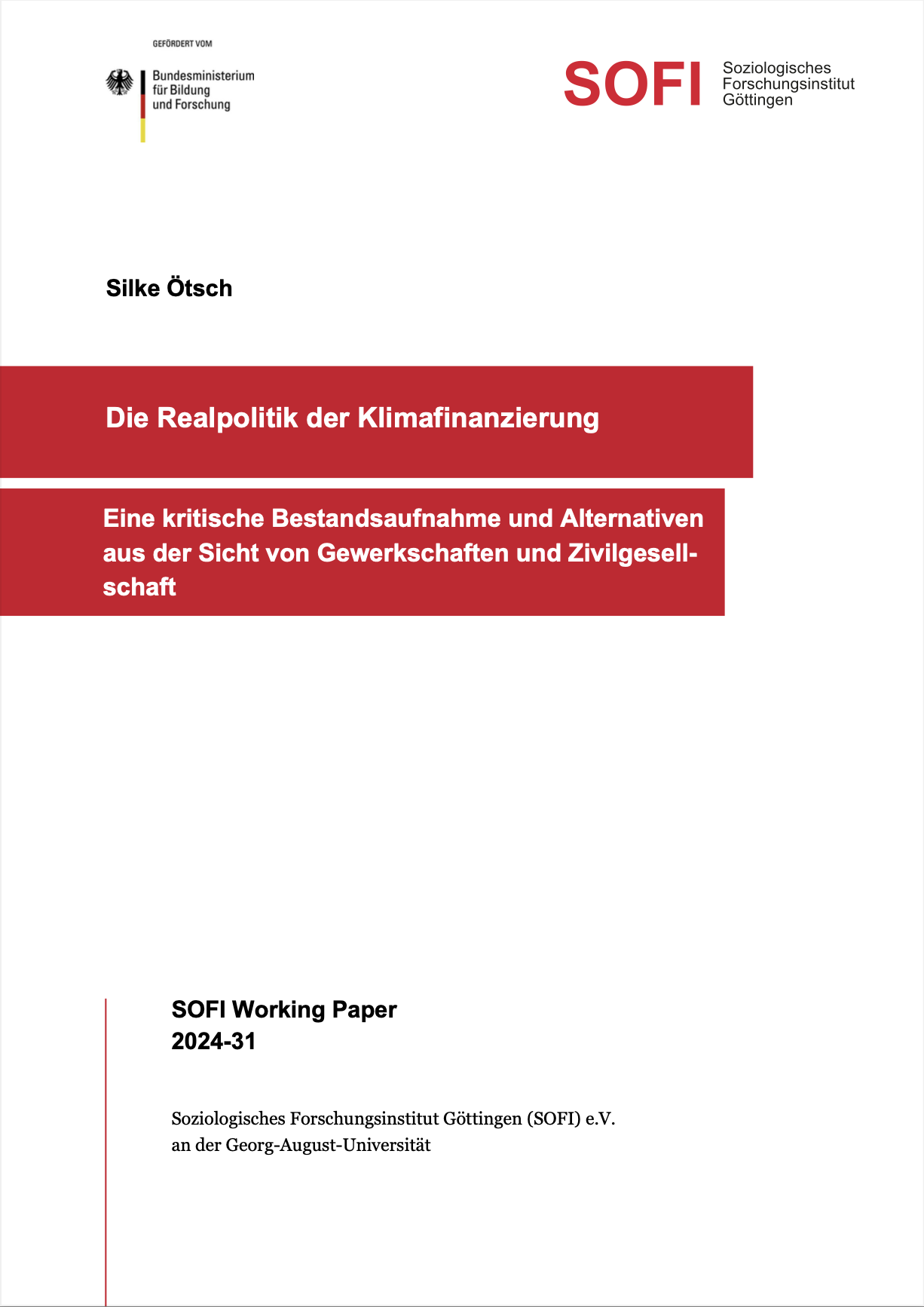
Die Realpolitik der Klimaschutzfinanzierung. Eine kritische Bestandsaufnahme und Alternativen aus der Sicht von Gewerkschaften und Zivilgesellschaft.
Der Beitrag beschäftigt sich mit derzeit verfolgten Politiken der Finanzierung von Klimaschutz und Anpassung an den Klimawandel und diskutiert Schwachstellen und Alternativen aus Perspektiven, die in diesem Bereich bislang unterrepräsentiert waren: aus der Sicht von Gewerkschaften, Umweltorganisationen und -bewegungen, des Globalen Südens und finanz- und wirtschaftskritischen Organisationen. Der Text gibt einen Überblick über die finanzielle und wirtschaftliche Dimension des Wandels. Er stellt die Klimafinanzierungspolitiken, insbesondere die Sustainable Finance-Initiative dar. Ein Zwischenfazit zeigt, dass die Politiken weniger erfolgreich sind als erhofft. Auf der Grundlage von 25 im Jahr 2023 geführten Interviews mit Expert:innen aus Gewerkschaften und Zivilgesellschaft werden Schwachpunkte und alternative Maßnahmen und Politiken aufgezeigt. Ich schließe, dass Politik und Finanzexpert:innen zu sehr auf wenig konfliktive freiwillige Verhaltensänderungen setzen und ökonomische, ökologische, soziale und demokratische Anliegen noch nicht ausreichend verbinden. Bislang ausgeklammerte Politiken und Instrumente im Bereich Ordnungspolitik, Geld- und Steuerpolitik sollten erwogen werden. Konflikte sollten nicht nur über Kommunikationsstrategien überdeckt, sondern in substanziellen Aushandlungsprozessen angegangen und ausgetragen werden.
- Veröffentlichungsdatum: 2024
- Autor:innen: Silke Ötsch
- Publikationsart: Working Paper
- Link zum PDF-Dokument
ClimFiSoc I Climate financing by the German government: a win-win strategy?

Climate financing by the German government:a win-win strategy?Perspectives from trade unions, and civil society and the need for a new conceptual framework
Dieser Artikel analysiert die Strategien und Maßnahmen der deutschen Regierung zur Klimafinanzierung und hinterfragt, ob diese Politiken das Versprechen einer sozial-ökologischen ökologischen Win-Win-Situation einlösen. Zentrale politische und wissenschaftliche Positionen zur nachhaltigen Finanzierung basieren auf diesem Versprechen. Der Artikel gibt zunächst einen Überblick über die Klima Finanzpolitik. Aufbauend auf einem analytischen Rahmen der kulturellen politischen Ökonomie, werden diese Politiken dann aus der relevanten, aber bisher unterrepräsentierten Perspektive von Gewerkschaften, Umweltverbänden und relevanten zivilgesellschaftlichen Akteure betrachtet. Die Analyse zeigt, dass die Bundesregierung im Vergleich zu anderen Ländern ein begrenztes Konzept von Klimafinanzierung bzw. nachhaltiger Finanzierung im Vergleich zur Sichtweise der Befragten nutzt. Im Sinne einer strategischen Selektivität ergreift die Regierung Maßnahmen aus einer finanzwirtschaftlichen einer finanzwirtschaftlichen und finanzwissenschaftlichen Perspektive, die das Problem als eine Frage der Information, Transparenz und Risikobepreisung sieht. Aus Sicht der Experten hingegen werden wirksamere Maßnahmen in den Bereichen Verteilungsfragen, Regulierung oder Geldpolitik, öffentliche Investitionen, Strukturpolitik und Mitbestimmung ausgeschlossen. Die Politik wird als sozial unausgewogen empfunden, was zu schwindender politischer Unterstützung führt. Um die Unterstützung der Bürgerinnen und Bürger zu gewinnen, braucht die Klimafinanzpolitik einen neuen konzeptionellen Rahmen.
- Veröffentlichungsdatum: 06.04.2024
- Autor:innen: Silke Ötsch
- Publikationsart: Working Paper
- Link zur Leseversion des Dokumentes
ClimFiSoc I Conversion: a strategy for ecosocial production politics
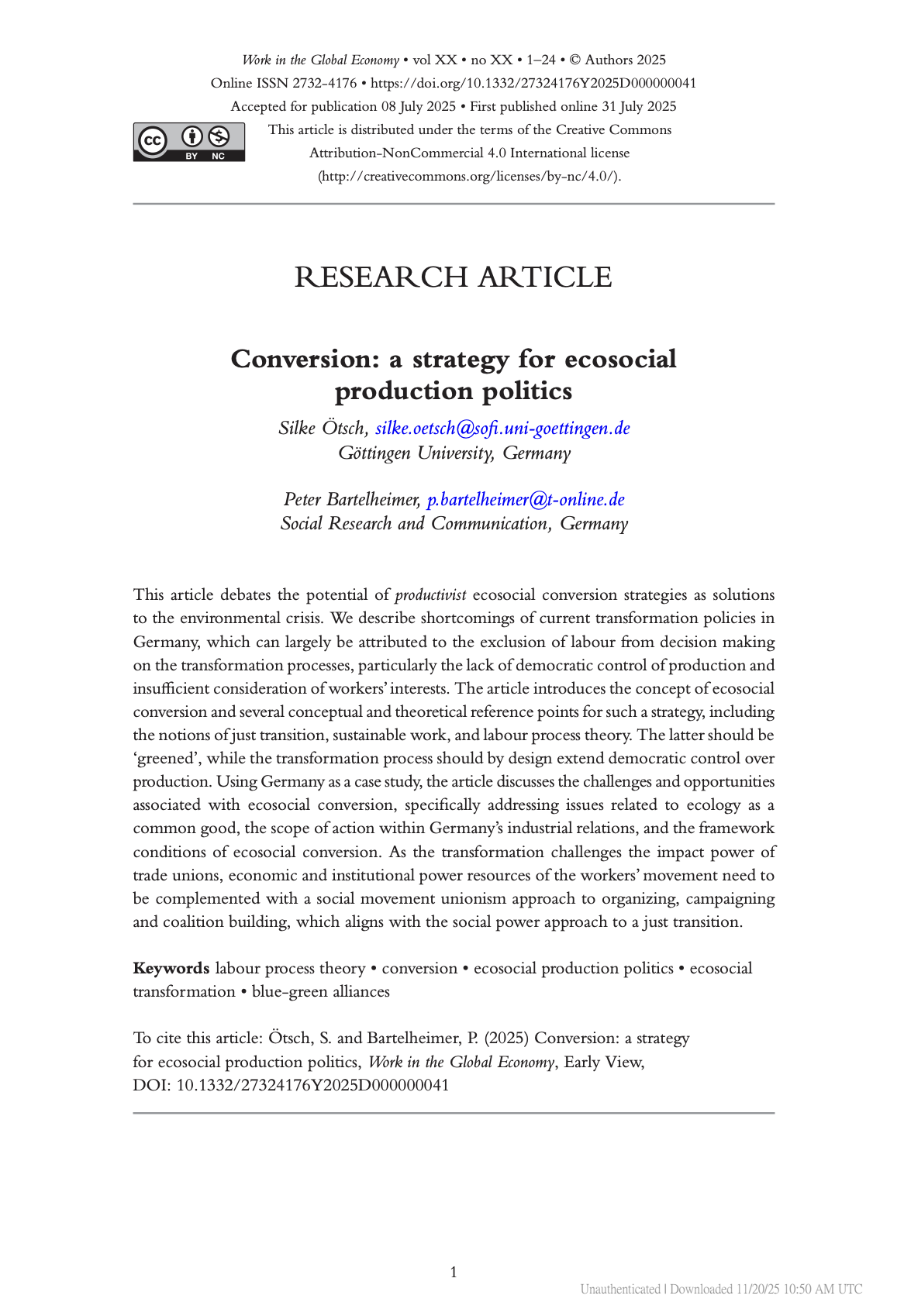
Conversion: a strategy for ecosocial production politics
This article debates the potential of productivist ecosocial conversion strategies as solutions to the environmental crisis. We describe shortcomings of current transformation policies in Germany, which can largely be attributed to the exclusion of labour from decision making on the transformation processes, particularly the lack of democratic control of production and insufficient consideration of workers’ interests. The article introduces the concept of ecosocial conversion and several conceptual and theoretical reference points for such a strategy, including the notions of just transition, sustainable work, and labour process theory. The latter should be ‘greened’, while the transformation process should by design extend democratic control over production. Using Germany as a case study, the article discusses the challenges and opportunities associated with ecosocial conversion, specifically addressing issues related to ecology as a common good, the scope of action within Germany’s industrial relations, and the framework conditions of ecosocial conversion. As the transformation challenges the impact power of trade unions, economic and institutional power resources of the workers’ movement need to be complemented with a social movement unionism approach to organizing, campaigning and coalition building, which aligns with the social power approach to a just transition.
- Veröffentlichungsdatum: 31.07.2025
- Autor:innen: Silke Ötsch
- Publikationsart: Research Article
- Link zum PDF-Dokument
ClimFiSoc I The European Investment Bank: the EU's climate bank?
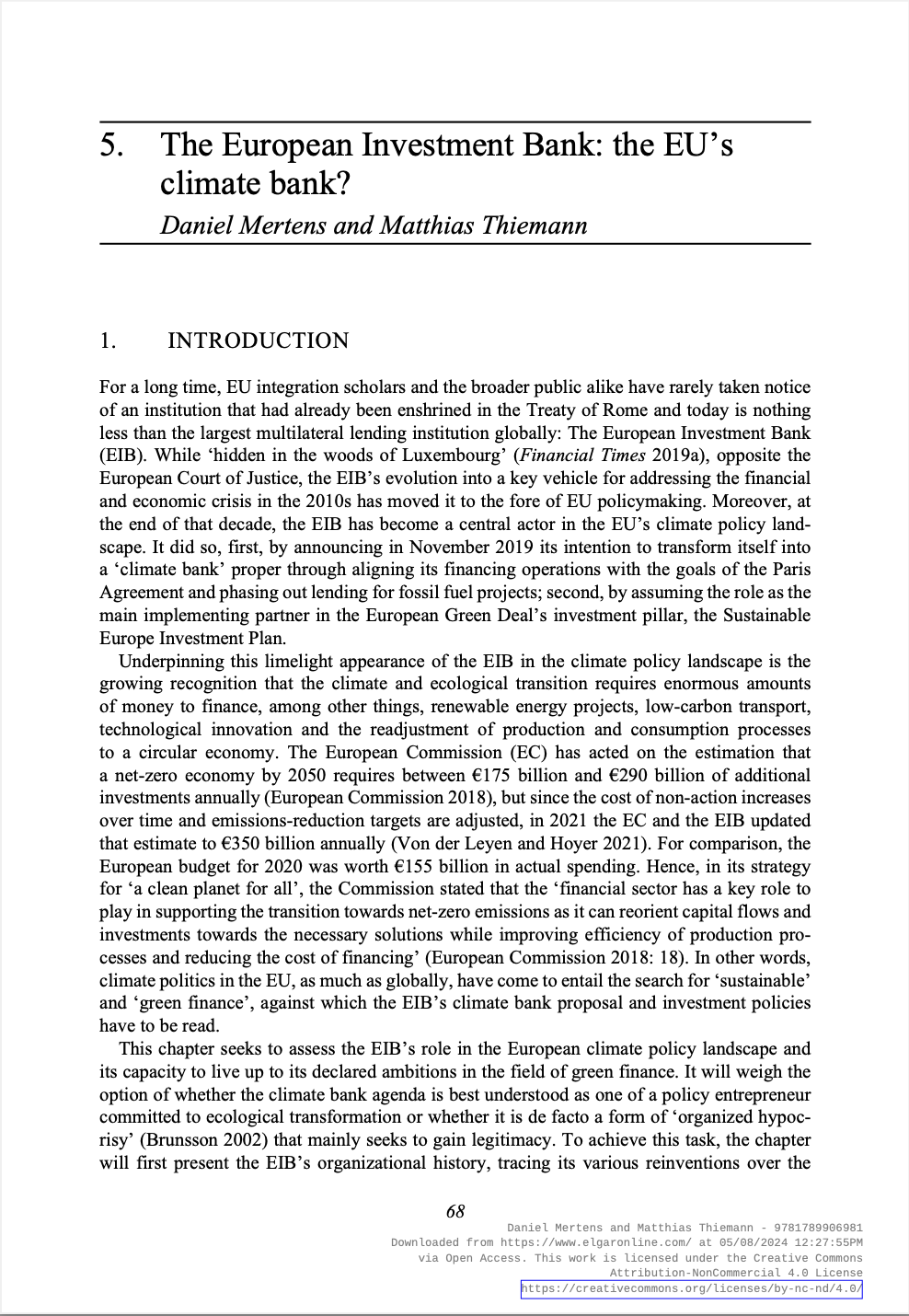
The European Investment Bank: the EU's climate bank?
This chapter evaluates the emerging role of the European Investment Bank in the EU’s climate policy landscape. To this end, it first reviews the organizational status and tasks of the EIB in the European Union and situates its role as a public financial institution in the global rise of ‘green finance’. It then moves on to explaining what the EIB means by proclaiming itself the EU’s ‘Climate Bank’, outlining the goals, volume, and functioning of the available financial instruments and resources for climate action. Based on this analysis, the chapter discusses the obstacles and politics of the ‘Climate Bank’ endeavor. While the efficacy of its climate action remains subject to future analysis, the EIB’s institutional position and the heterogeneous interests present in the multilateral bank raise doubts about the scope and effectiveness of the bank’s reorientation.
- Veröffentlichungsdatum: 14.07.2024
- Autor:innen: Daniel Mertens & Matthias Thiemann
- Publikationsart: Publikation
- Link zum PDF-Dokument
ClimLabels I Financing the Economic Transition — On the Role of Labels for Retail Investors

Financing the Economic Transition — On the Role of Labels for Retail Investors
The economic transition from a fossil-fueled economy to a green economy requires sub- stantial financing, including contributions from retail investors. What determines retail in- vestors’ willingness to pay (WTP) for sustainable investments is, however, an open ques- tion. In this paper, we address this question by examining the role of information and its presentation—particularly through labels—for retail investors’ WTP for sustainable invest- ments. Using an incentivized experiment with 1,219 German retail investors, we analyze how different presentations of information on environmental impact—ranging from plain text to labels with scores from one to five, under both loose and strict labeling standards— impact WTP. Our findings reveal that while retail investors exhibit a significant WTP for environmental impact, this WTP is only weakly influenced by the actual extent of this im- pact. Labels play a critical role: more demanding label standards enhance the sensitivity of WTP to environmental impact, whereas more lenient standards diminish this sensitivity. Moreover, warm-glow utility emerges as a key driver of the WTP for environmental impact. Higher label scores increase warm-glow utility even in the absence of changes in actual im- pact. Finally, the effect of warm-glow utility on WTP is stronger in label treatments.
- Veröffentlichungsdatum: 03.04.2025
- Autor:innen: Markus Dertwinkel-Kalt, Astrid Eller, Christoph Feldhaus, Leon Landes & Andreas Löschel
- Publikationsart: Working Paper
- Link zum PDF-Dokument
ClimLabels I Integrating “transition” more systematically into finance
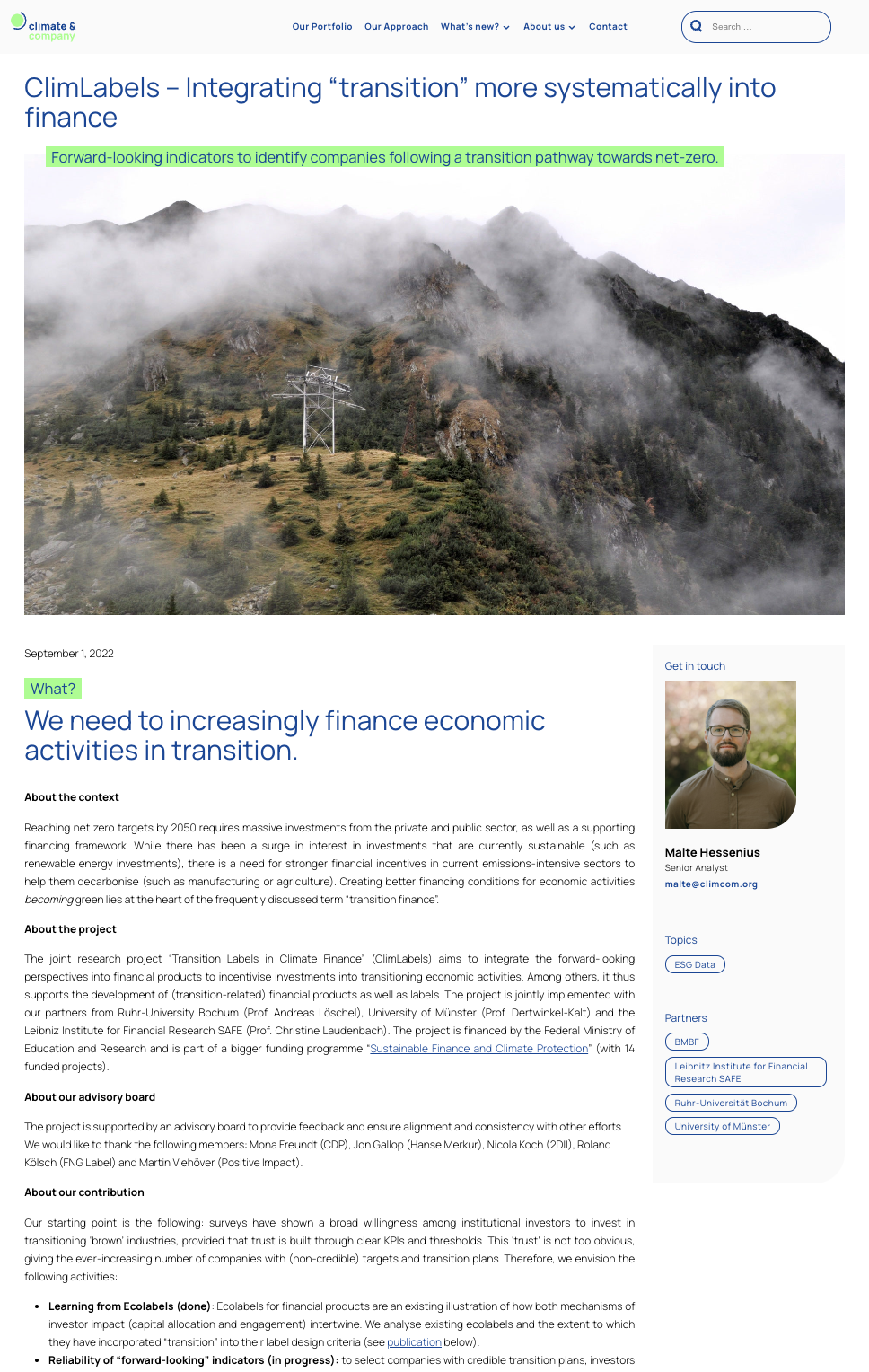
ClimLabels - Integrating “transition” more systematically into finance Forward-looking indicators to identify companies following a transition pathway towards net-zero.
About the context: Reaching net zero targets by 2050 requires massive investments from the private and public sector, as well as a supporting financing framework. While there has been a surge in interest in investments that are currently sustainable (such as renewable energy investments), there is a need for stronger financial incentives in current emissions-intensive sectors to help them decarbonise (such as manufacturing or agriculture). Creating better financing conditions for economic activities becoming green lies at the heart of the frequently discussed term “transition finance”. About the project: The joint research project “Transition Labels in Climate Finance” (ClimLabels) aims to integrate the forward-looking perspectives into financial products to incentivise investments into transitioning economic activities. Among others, it thus supports the development of (transition-related) financial products as well as labels. The project is jointly implemented with our partners from Ruhr-University Bochum (Prof. Andreas Löschel), University of Münster (Prof. Dertwinkel-Kalt) and the Leibniz Institute for Financial Research SAFE (Prof. Christine Laudenbach). The project is financed by the Federal Ministry of Education and Research and is part of a bigger funding programme “Sustainable Finance and Climate Protection” (with 14 funded projects).
- Veröffentlichungsdatum: 01.09.2022
- Autor:innen: Malte Hessenius
- Publikationsart: Website-Beitrag
- Link zum Beitrag
ClimLabels I Investor Impact in Transition Finance: Learning from Ecolabels
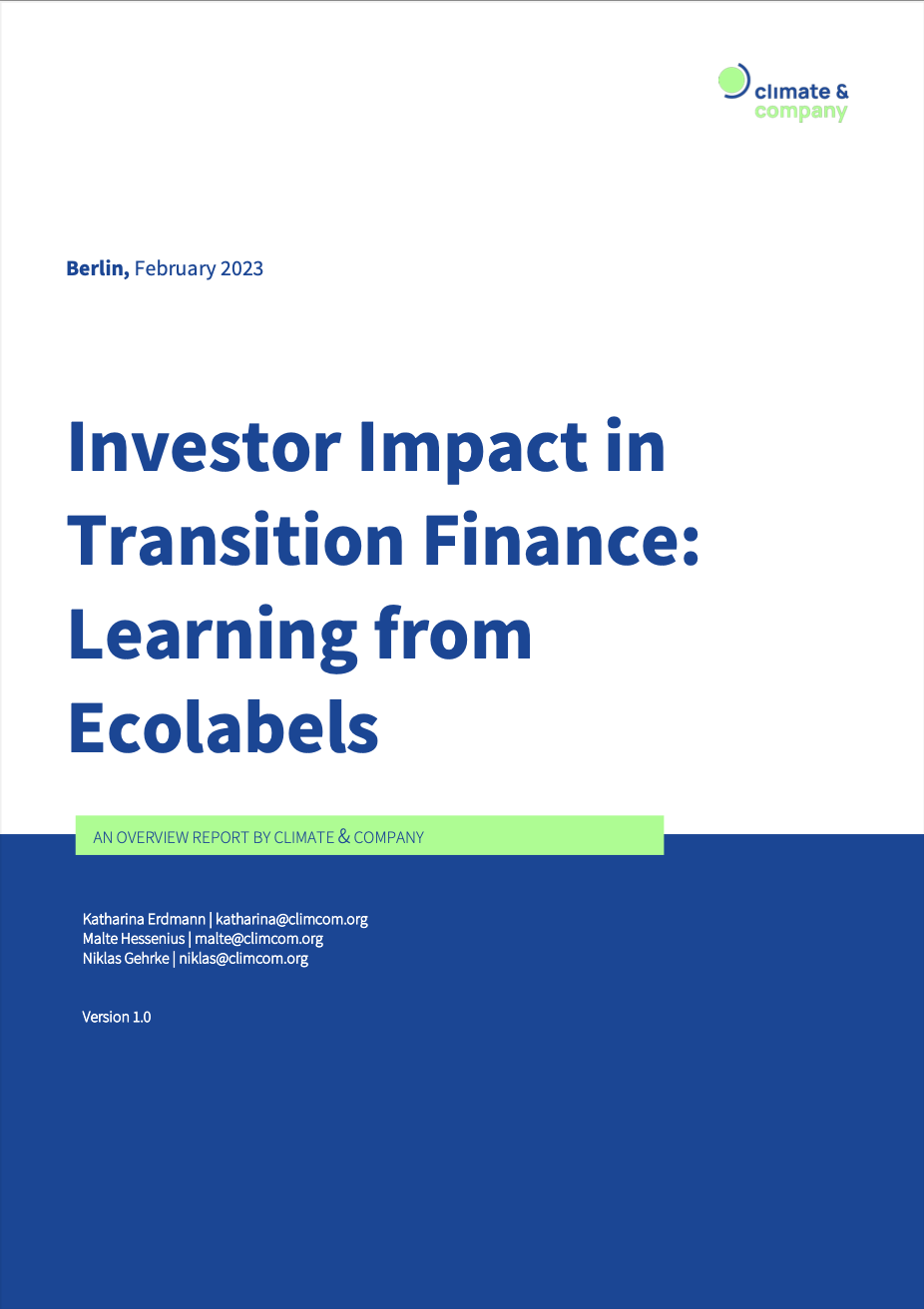
Investor Impact in Transition Finance: Learning from Ecolabels
This publication is a first overview paper, originating from our ClimLabels project. This paper sheds light on the evolving transition finance landscape with a particular focus on Ecolabels and what we can learn from them to construct transition finance products. This paper builds partially on our input on the UK’s proposed transition label.
- Veröffentlichungsdatum: 21.02.2023
- Autor:innen: Katharina Erdmann, Malte Hessenius & Niklas Gehrke
- Publikationsart: Overview Report
- Link zum PDF-Dokument
ClimLabels I Remarks on UK’s proposed transition investment label
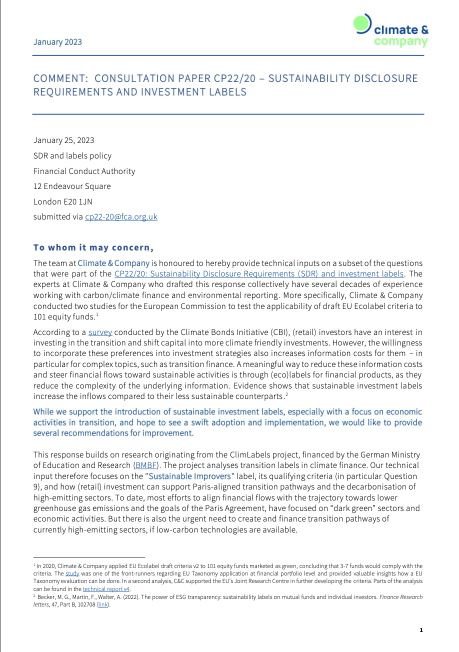
Remarks on UK’s proposed transition investment label
The UK Financial Conduct Authority (FCA) has proposed three sustainable investment labels (i.e., sustainable focus, sustainable improvers, sustainable impact) in the form of a consultation paper (link). Our response to the consultation builds on research originating from our ClimLabels project, financed by the German Ministry of Education and Research (BMBF). The project analyses transition labels in climate finance. Our technical input therefore focuses on the “Sustainable Improvers” label, its qualifying criteria (in particular Question 9), and how (retail) investment can support Paris-aligned transition pathways and the decarbonisation of high-emitting sectors. To date, most efforts to align financial flows with the trajectory towards lower greenhouse gas emissions and the goals of the Paris Agreement, have focused on “dark green” sectors and economic activities. But there is also the urgent need to create and finance transition pathways of currently high-emitting sectors, if low-carbon technologies are available. Our main recommendations to improve the “Sustainable Improvers” label are the following: A clear reference to the Paris Agreement and the UK climate/ environmental targets creates the necessary ambition and prevents greenwashing. A reduction of the investable universe by excluding high-impact companies without transition plans increases the credibility of the label. Specific requirements for the engagement process for the manager of the fund improves the success rate of the stewardship process.
- Veröffentlichungsdatum: 26.01.2023
- Autor:innen: Katharina Erdmann
- Publikationsart: Paper
- Link zum PDF-Dokument
ClimLabels I Transition Products: Conceptual Clarity & Implementation Guidance

Transition Products: Conceptual Clarity & Implementation Guidance
This white paper is part of a wider discussion about new regulatory efforts in the EU, UK and beyond to categorise financial products with sustainability features. This report focuses on the category of ‘transition products’ in public equity markets. By reviewing existing proposals for transition products, we identify their key characteristics and potential criteria. As a next step, we illustrate the application of the potential criteria using a global universe of listed companies to provide evidence-based feedback to decision-makers.
- Veröffentlichungsdatum: 24.06.2024
- Autor:innen: Dr. Raphael Tietmeyer & Malte Hessenius
- Publikationsart: Paper
- Link zum PDF-Dokument
Climvest I Towards Granular Climate Transparency in Mutual Funds: Informing the SFDR Review
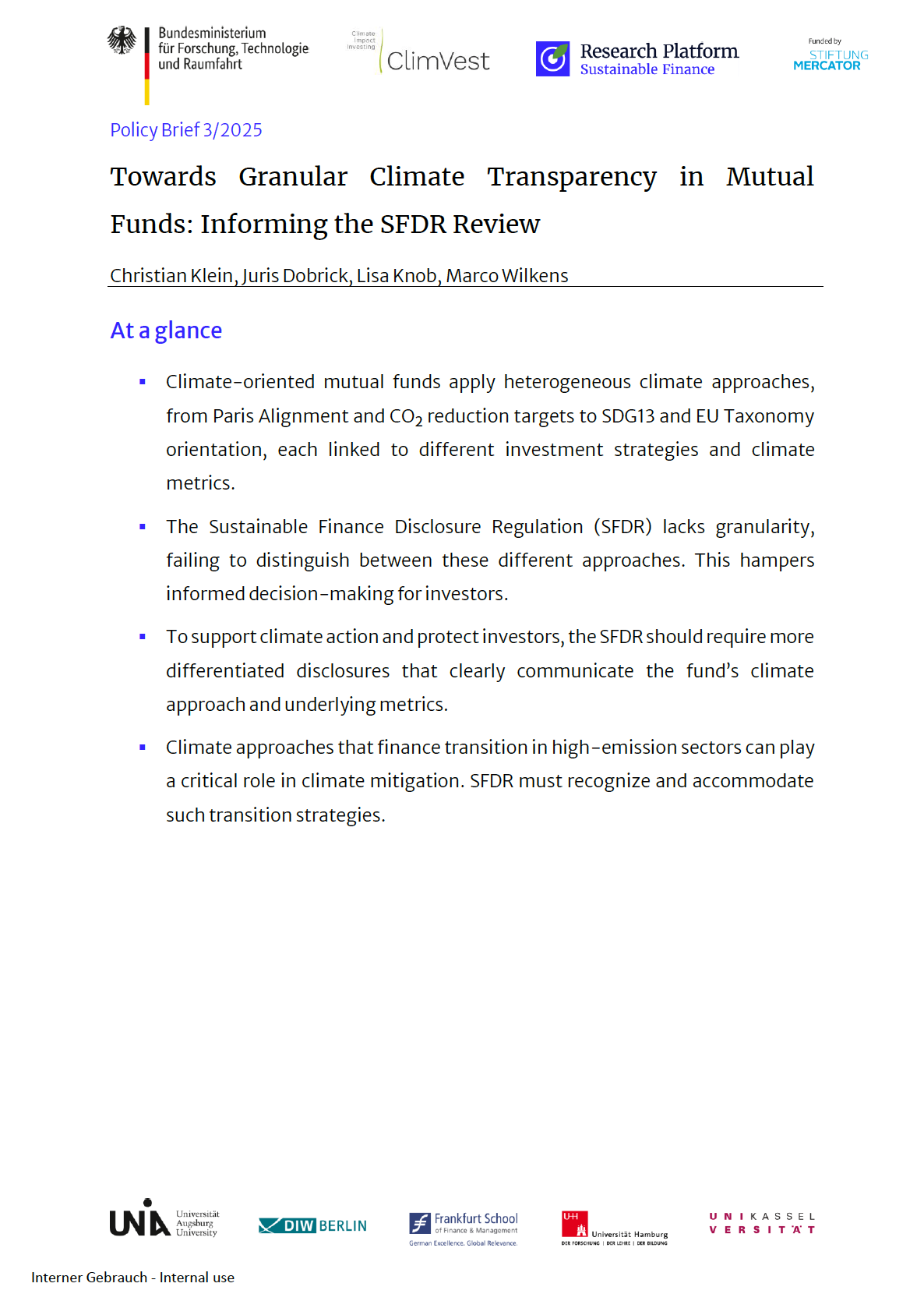
Towards Granular Climate Transparency in Mutual Funds: Informing the SFDR Review
Capital markets are supposed to play a central role in closing the climate investment gap (European Commission 2018; Andersen 2022). Mutual funds, as widely used investment products, are increasingly expected to channel capital towards closing the finance gap to achieve the goals of the Paris Agreement (Andersen 2022). Recent regulatory initiatives such as the SFDR aim to enhance transparency around the sustainability information of such funds, thereby empowering investors to make informed decisions and ensuring that capital is steered towards the transition to a net-zero economy. However, despite these efforts, the current disclosure regime does not sufficiently reflect the diversity and complexity of climate approaches employed by climateoriented mutual funds. Investors might face challenges in understanding what a fund’s climate approachactually implies (Andrikogiannopoulou et al. 2022). This lack of granularity, also found as a general research restriction in sustainability (Edmans 2023), is particularly problematic in light of the heterogeneity among climateoriented funds, which differ substantially in terms of their strategic approach (Popescu et al. 2021), e.g., Paris-aligned, CO₂ reduction-focused, SDG13-driven, or EU Taxonomy-based This policy brief summarizes key findings from a recent empirical study on 622 European climate-oriented mutual funds, which identifies four dominant climate strategies and analyzes their relationship with specific climate metrics and financial performance. The findings provide timely and policy-relevant insights for the ongoing revision of the SFDR. They underline the importance of recognizing transition-oriented investment strategies and advocate for a more differentiated disclosure framework that enables investors and regulators alike to distinguish between distinct climate approaches within the fund universe.
- Veröffentlichungsdatum: März 2025
- Autor:innen: Christian Klein, Juris Dobrick, Lisa Knob, Marco Wilkens
- Publikationsart: Policy Brief
- Link zum PDF-Dokument
CONFILIENCE I How to provide actionable information on weather and climate impacts? A summary of strategic, methodological, and technical perspectives
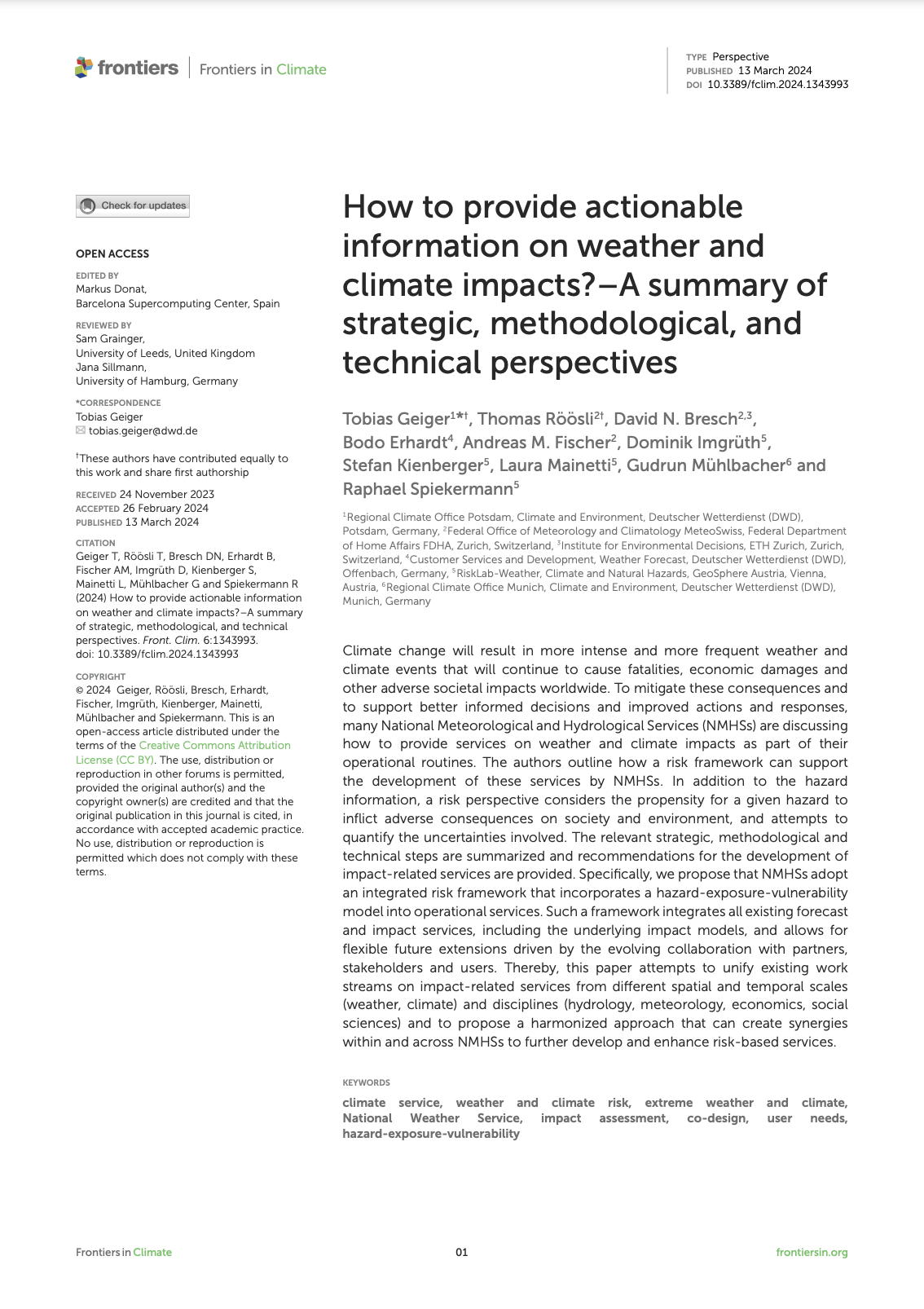
How to provide actionable information on weather and climate impacts? A summary of strategic, methodological, and technical perspectives
Climate change will result in more intense and more frequent weather and climate events that will continue to cause fatalities, economic damages and other adverse societal impacts worldwide. To mitigate these consequences and to support better informed decisions and improved actions and responses, many National Meteorological and Hydrological Services (NMHSs) are discussing how to provide services on weather and climate impacts as part of their operational routines. The authors outline how a risk framework can support the development of these services by NMHSs. In addition to the hazard information, a risk perspective considers the propensity for a given hazard to inflict adverse consequences on society and environment, and attempts to quantify the uncertainties involved. The relevant strategic, methodological and technical steps are summarized and recommendations for the development of impact-related services are provided. Specifically, we propose that NMHSs adopt an integrated risk framework that incorporates a hazard-exposure-vulnerability model into operational services. Such a framework integrates all existing forecast and impact services, including the underlying impact models, and allows for flexible future extensions driven by the evolving collaboration with partners, stakeholders and users. Thereby, this paper attempts to unify existing work streams on impact-related services from different spatial and temporal scales (weather, climate) and disciplines (hydrology, meteorology, economics, social sciences) and to propose a harmonized approach that can create synergies within and across NMHSs to further develop and enhance risk-based services.
- Veröffentlichungsdatum: 23.03.2024
- Autor:innen: Tobias Geiger, Thomas Röösli, David N. Bresch, Bodo Erhardt, Andreas M. Fischer, Dominik Imgrüth, Stefan Kienberger, Laura Mainetti, Gudrun Mühlbacher & Raphael Spiekermann
- Publikationsart: Paper
- Link zum PDF-Dokument
- Keywords: climate service, weather and climate risk, extreme weather and climate, National Weather Service, impact assessment, co-design, user needs, hazard-exposure-vulnerability
CREATE I Analyse der EU-Taxonomiekriterien und der zum Nachweis der Einhaltung erforderlichen Daten

Analyse der EU-Taxonomiekriterien und der zum Nachweis der Einhaltung erforderlichen Daten
Der Bericht beschreibt erste Projektergebnisse aus dem Forschungsprojekt CREATE.
- Veröffentlichungsdatum: 29.05.2024
- Autor:innen: Dr. Anna Braune, Seema Issar & Eva-Maria Stumpp
- Publikationsart: Bericht
- Link zum PDF-Dokument
CREATE I Klimaneutrale Transformation des Immobiliensektors über den Kapitalmarkt

Klimaneutrale Transformation des Immobiliensektors über den Kapitalmarkt
Das Positionspapier erörtert maßgeschneiderte Lösungen für die Finanzierung moderner Renovierungsprozesse, die auch die Herausforderungen und Chancen des seriellen Sanierens und des Contractings berücksichtigen. Der Erfolg dieser Bemühungen hängt davon ab, inwieweit Gebäudedaten standardisiert und digitale Werkzeuge zur Analyse genutzt werden und unser gebündeltes Fachwissen eingesetzt wird, um Verbraucher/- innen über die Vorteile und Machbarkeit nachhaltiger Renovierungen aufzuklären und ihnen zugleich die passenden Finanzierungsprodukte anzubieten.
- Veröffentlichungsdatum: Oktober 2024
- Autor:innen: Prof. Dr. Tobias Popovic, Dr. Philipp Veit, Max Weber, Robert E. Bopp, Bernd Nauerz
- Publikationsart: Positionspapier
- Link zum PDF-Dokument
CREATE I Sanierungs-Offensive für Deutschland - Wege zur klimaneutralen Gebäudepolitik
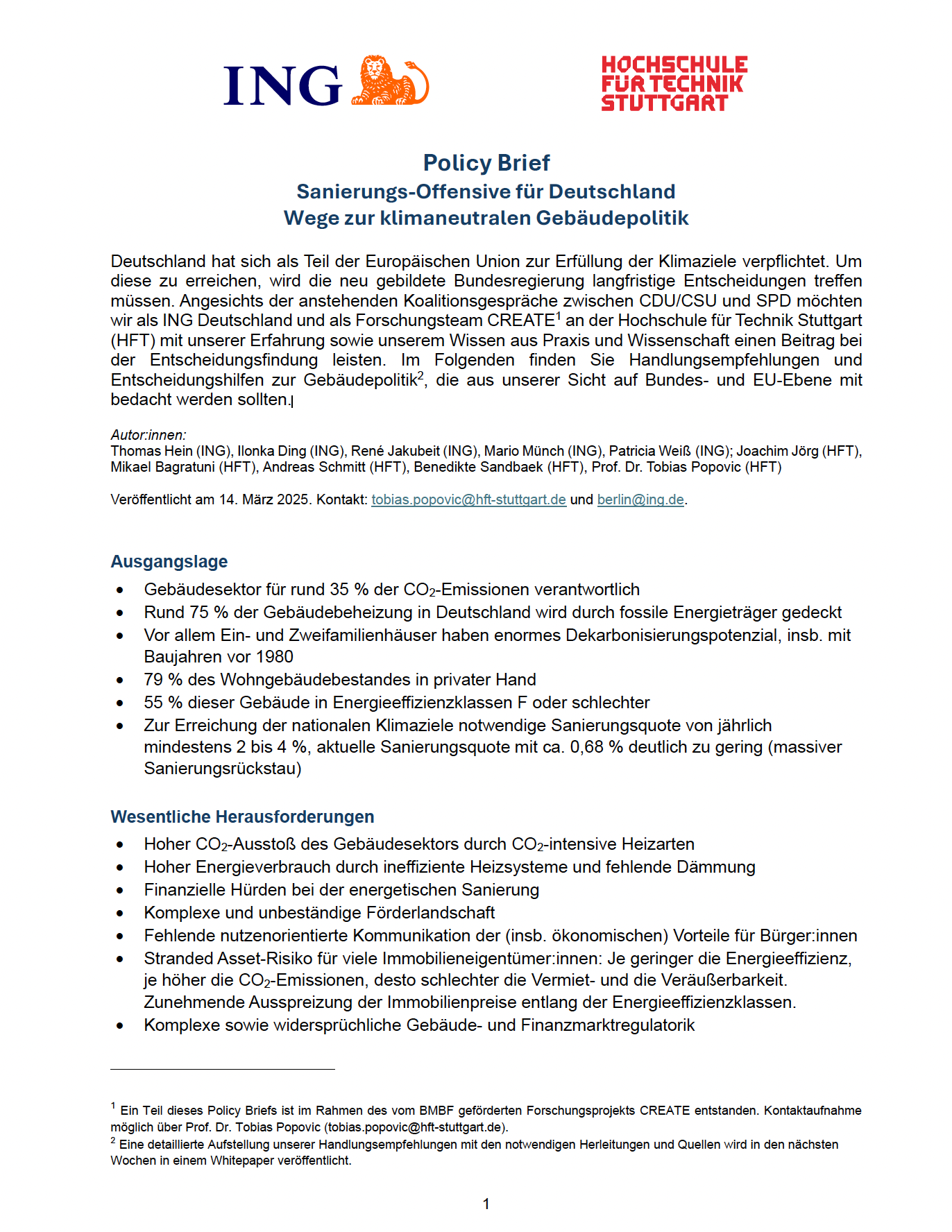
Sanierungs-Offensive für Deutschland - Wege zur klimaneutralen Gebäudepolitik
Deutschland hat sich als Teil der Europäischen Union zur Erfüllung der Klimaziele verpflichtet. Um diese zu erreichen, wird die neu gebildete Bundesregierung langfristige Entscheidungen treffen müssen. Angesichts der anstehenden Koalitionsgespräche zwischen CDU/CSU und SPD möchten wir als ING Deutschland und als Forschungsteam CREATE1 an der Hochschule für Technik Stuttgart (HFT) mit unserer Erfahrung sowie unserem Wissen aus Praxis und Wissenschaft einen Beitrag bei der Entscheidungsfindung leisten. Im Folgenden finden Sie Handlungsempfehlungen und Entscheidungshilfen zur Gebäudepolitik2, die aus unserer Sicht auf Bundes- und EU-Ebene mit bedacht werden sollten.
- Veröffentlichungsdatum: 14.03.2025
- Autor:innen: Thomas Hein, Ilonka Ding, René Jakubeit, Mario Münch, Patricia Weiß, Joachim Jörg, Mikael Bagratuni, Andreas Schmitt, Benedikte Sandbaek, Prof. Dr. Tobias Popovic
- Publikationsart: Policy Brief
- Link zum PDF-Dokument
CREATE I Sanierungs-Offensive für Deutschland - Wege zur klimaneutralen Gebäudepolitik
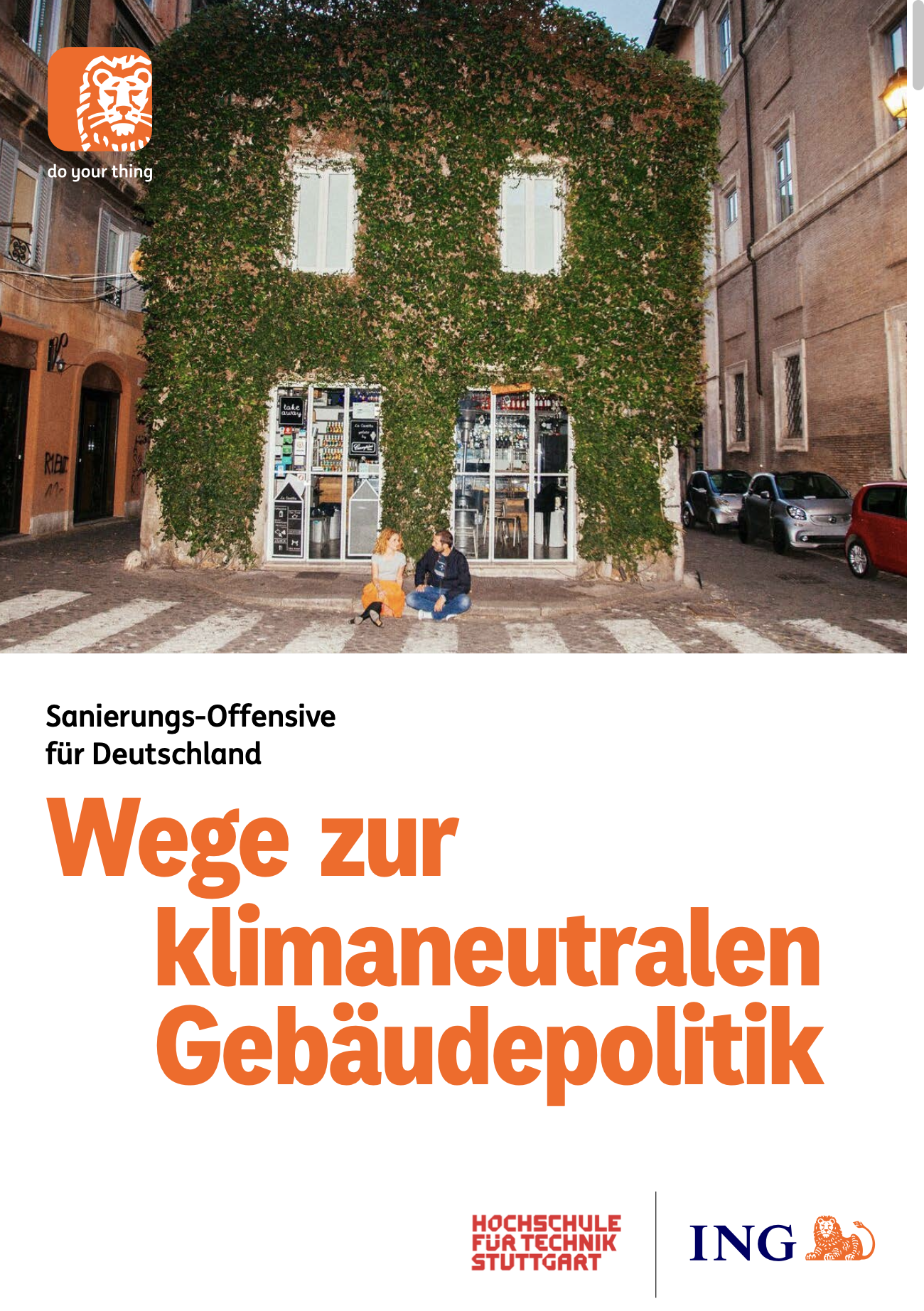
Sanierungs-Offensive für Deutschland - Wege zur klimaneutralen Gebäudepolitik
Deutschland hat sich als Teil der Europäischen Union zur Erfüllung der Klimaziele verpflichtet. Um diese zu erreichen, wird die neu gebildete Bundesregierung langfristige Entscheidungen treffen müssen. Angesichts dessen möchten wir als ING Deutschland1 und als Forschungsteam CREATE2 an der Hochschule für Technik Stuttgart (HFT) mit unserer Erfahrung sowie unserem Wissen aus Praxis und Wissenschaft3 einen Beitrag zur politischen Beratung leisten. Bereits in früheren Analysen wurde deutlich, dass die bestehenden Regelungen nicht ausreichen, um Klimaneutralität im Gebäudesektor sicherzustellen. Sanierungstempo und -tiefe müssen deutlich gesteigert werden. Dafür braucht es übergreifende Konzepte, die energetische Sanierungen wirtschaftlich attraktiver machen als den Status quo – und diese sowohl fördern als auch fordern. Die Transformation gelingt nur, wenn alle relevanten Akteure gemeinsam handeln – von der Politik über die Finanzwirtschaft bis hin zu Eigentümer:innen und Energieversorgern. Innovative Finanzierungsmodelle und datenbasierte Instrumente sind entscheidend, um Investitionen gezielt zu lenken und die Umsetzung zu beschleunigen. Im Folgenden sind Handlungsempfehlungen und Entscheidungshilfen zur Gebäudepolitik zu finden, welche aus unserer Sicht auf Bundes- und EU-Ebene mit bedacht werden sollten.
- Autor:innen: Joachim Jörg Mikael Bagratuni Andreas Schmitt Benedikte Sandbaek Prof. Dr. Tobias Popovic, Thomas Hein, Ilonka Ding, René Jakubeit, Mario Münch, Patricia Weiß
- Publikationsart: White Paper
- Link zum PDF-Dokument
CREATE I Transforming Cities - Welchen Beitrag können Finanzmärkte zur Großen Transformation leisten?

Transforming Cities - Welchen Beitrag können Finanzmärkte zur Großen Transformation leisten?
Die Bewältigung des Klimawandels erfordert eine umfassende Transformation von Wirtschaft und Gesellschaft. Finanzmärkte spielen hierbei eine entscheidende Rolle, indem sie Kapitalströme in nachhaltige Investitionen umlenken. Ein zentraler Bestandteil ist die Transformationsfinanzierung, die Aktivitäten zur Erreichung der Klimaneutralität fördert. Ziel ist, durch innovative Finanzierungsmodelle und möglichst standardisierten Transitionspläne Investitionen mit hohem CO2-Reduktionspotenzial im Gebäudebereich zu priorisieren, um so die größtmögliche transformative Wirkung zu erreichen. Dieser Ansatz bietet erhebliche Potenziale zur Beschleunigung der Gebäudetransformation.
- Autor:innen: Andreas Schmitt, Joachim Jörg, Benedikte Sandbaek, Tobias Popović
- Link zum PDF-Dokument
CREATE I Transforming Cities - Wie kann die Wohngebäudeversicherung zur klimaneutralen Transformation von Gebäuden beitragen?
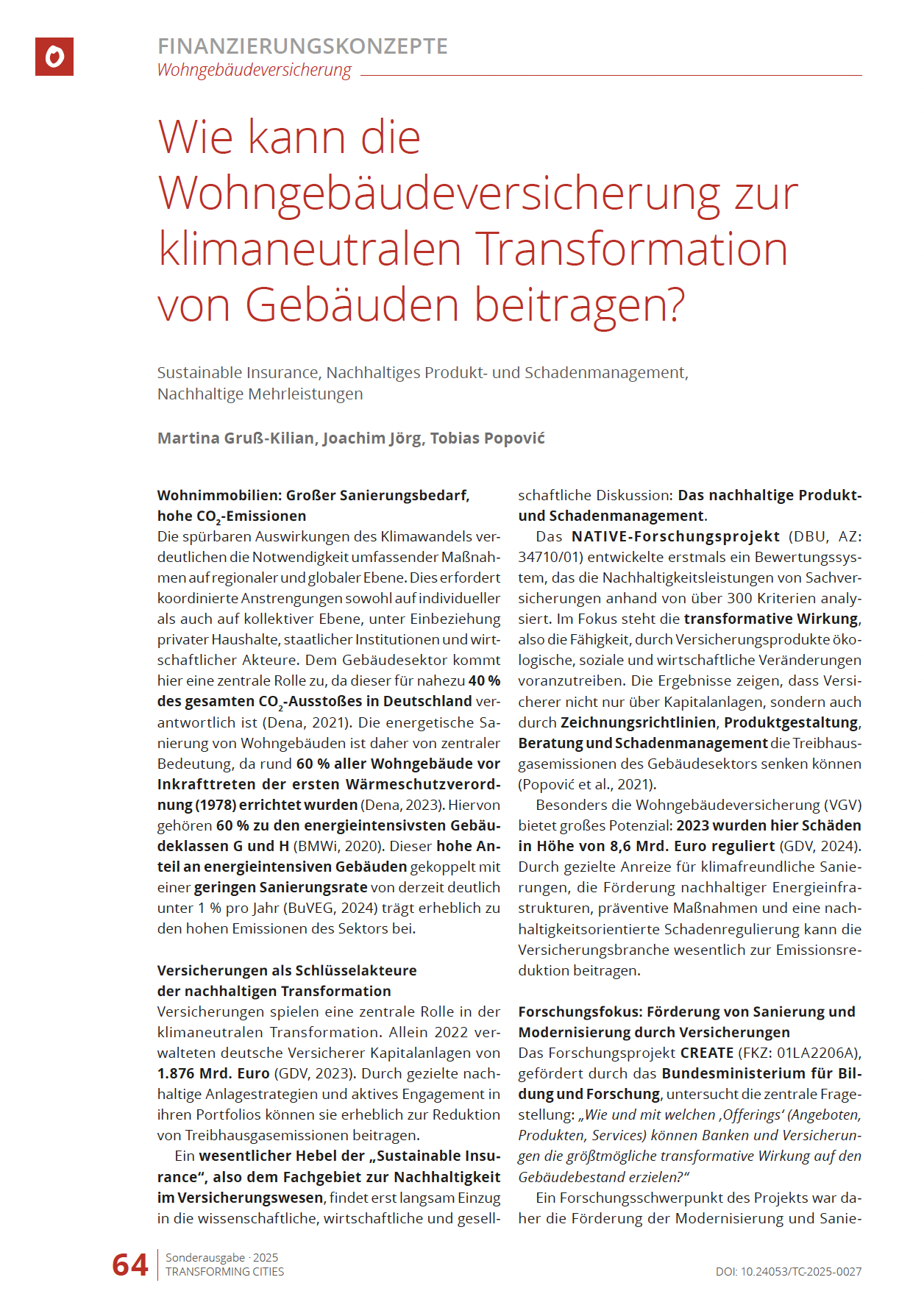
Transforming Cities - Wie kann die Wohngebäudeversicherung zur klimaneutralen Transformation von Gebäuden beitragen?
Die spürbaren Auswirkungen des Klimawandels verdeutlichen die Notwendigkeit umfassender Maßnahmen auf regionaler und globaler Ebene. Dies erfordert koordinierte Anstrengungen sowohl auf individueller als auch auf kollektiver Ebene, unter Einbeziehung privater Haushalte, staatlicher Institutionen und wirtschaftlicher Akteure. Dem Gebäudesektor kommt hier eine zentrale Rolle zu, da dieser für nahezu 40 % des gesamten CO2-Ausstoßes in Deutschland verantwortlich ist (Dena, 2021). Die energetische Sanierung von Wohngebäuden ist daher von zentraler Bedeutung, da rund 60 % aller Wohngebäude vor Inkrafttreten der ersten Wärmeschutzverordnung (1978) errichtet wurden (Dena, 2023). Hiervon gehören 60 % zu den energieintensivsten Gebäudeklassen G und H (BMWi, 2020). Dieser hohe Anteil an energieintensiven Gebäuden gekoppelt mit einer geringen Sanierungsrate von derzeit deutlich unter 1 % pro Jahr (BuVEG, 2024) trägt erheblich zu den hohen Emissionen des Sektors bei.
- Autor:innen: Martina Gruß-Kilian, Joachim Jörg, Tobias Popović
- Link zum PDF-Dokument
CREATE I Transforming Cities Sonderausgabe - Urbane Transformation
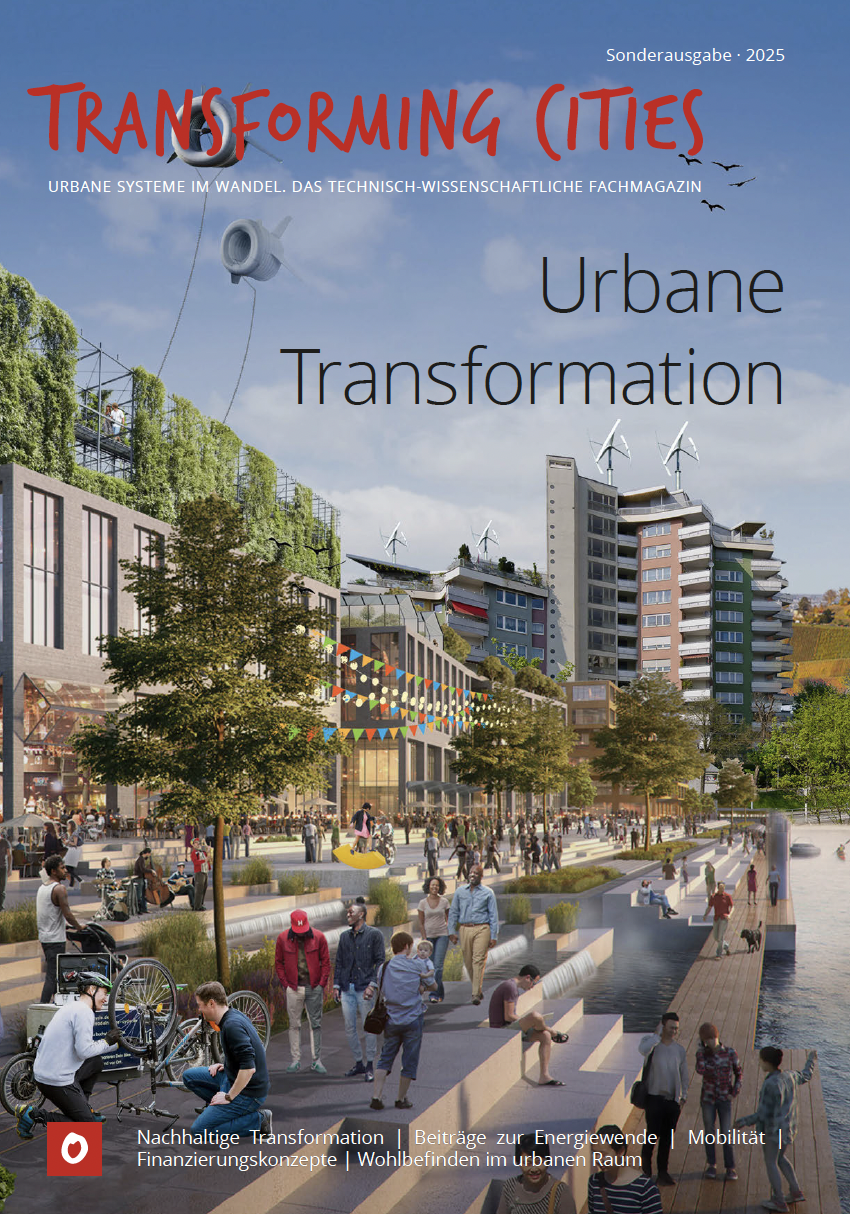
Transforming Cities Sonderausgabe - Urbane Transformation
Transforming Cities ist ein Fachmagazin mit technisch-wissenschaftlichen Beiträgen für Fachleute und Interessierte. Es beinhaltet Beiträge zu den Themen: zukunftsweisender Umgang mit Energie und Ressourcen, urbane Mobilität, Erhalt und Ausbau städtischer Infrastruktur, neue Formen von Kommunikation und Schaffung lebenswerter Stadträume.
FEIRE I Höhe und Verteilung der gesellschaftlichen Kosten heizbedingter Emissionen
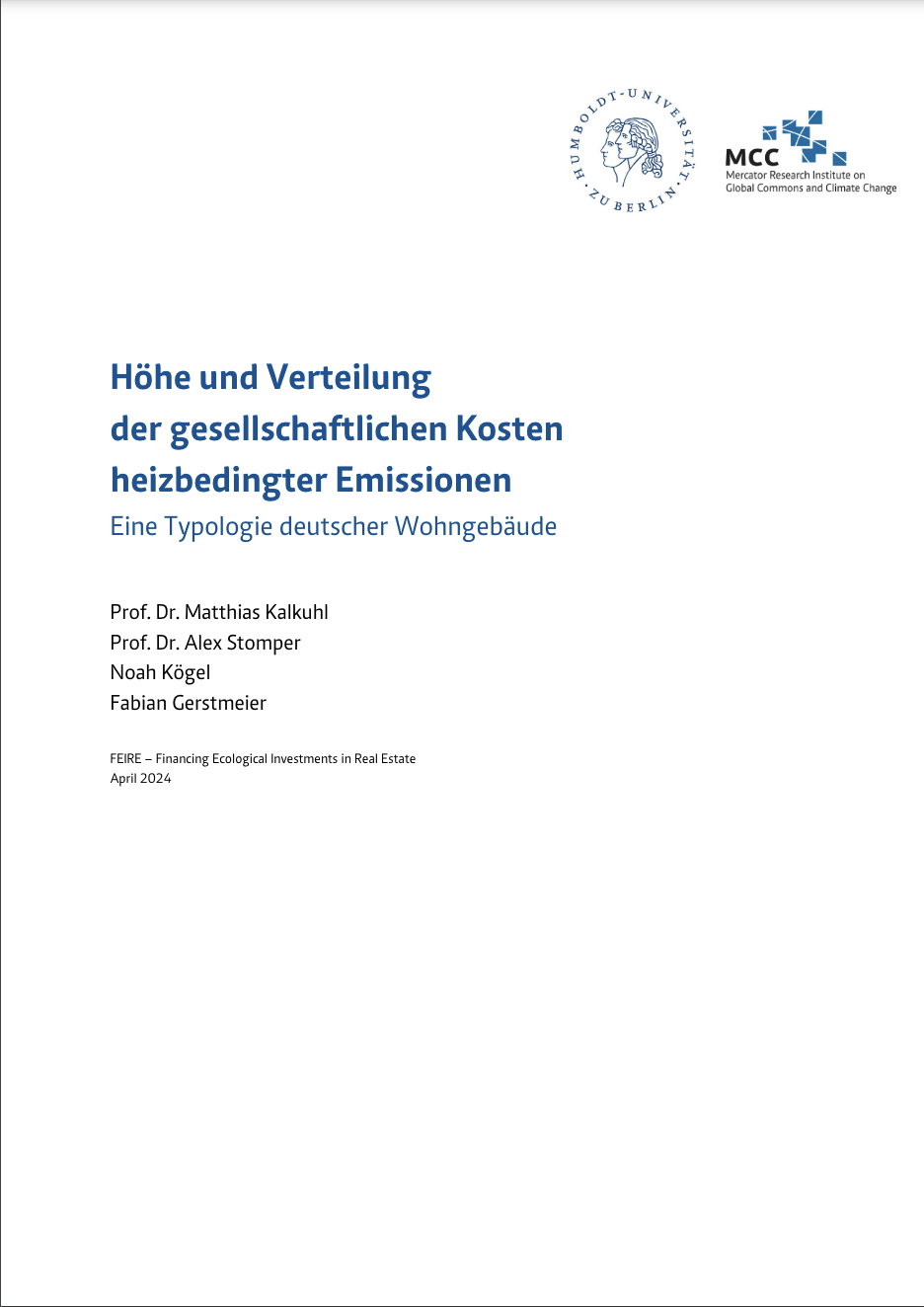
Höhe und Verteilung der gesellschaftlichen Kosten heizbedingter Emissionen
Der vorliegende Bericht quantifiziert die gesellschaftlichen Kosten des gegenwärtigen Heizsystems an-hand der damit verbundenen CO2- Emissionen im deutschen Wohngebäudesektor, der zu einem großen Teil (ca. 75%, DESTATIS (2019)) dezentral mit fossilen Energieträgern beheizt wird. Die gesellschaftlichen Kosten lassen sich transparent anhand der jährlich anfallenden CO2-Kosten aller Haushalte in einem Sze-nario bewerten, in dem die heizbedingten Emissionen über die Jahre gleich bleiben und ein volkswirtschaftlich optimaler CO2-Preispfad angenommen wird, der die Erreichung der europäischen Klimaziele sicherstellt (Pietzcker, et al., 2021). Dieser Preispfad gibt an, zu welchen Kosten weitere CO2-Emissionen vermieden werden müssten, wenn die Emissionsvermeidung im Wohngebäudesektors ausbliebe und sie daher in einem anderen Sektor stattfinden müsste. Das Ergebnis der Bewertung beläuft sich – unter Annahme eines gegenüber 2018 unveränderten Heizverhaltens der Haushalte – zwischen 2023 und 2045 auf ca. 580 Mrd. EUR. Bezogen auf die Wohnraumfläche betragen die kapitalisierten Kosten in diesem Zeitraum 148 EUR pro Haushalt und m² bei einer Standardabweichung von 124 EUR pro Quadratmeter Wohnfläche. Diese hohe Standardabweichung reflektiert das Ausmaß der Heterogenität im Energiebedarf deutscher Wohngebäude. Das Ergebnis kann als Richtwert dienen, um kosteneffiziente Maßnahmen zur Vermeidung von CO2-Emissionen im Wohngebäudesektor zu identifizieren. Unsere Ergebnisse schätzen jedoch auch ab, ab welchem Investitionsbedarf eine energetische Modernisierung tendenziell nicht sinnvoll ist, weil es günstiger wäre, die Emissionseinsparungen außerhalb des Gebäudesektors oder zu einem späteren Zeitpunkt im Gebäudesektor zu realisieren.
- Veröffentlichungsdatum: 08.04.2024
- Autor:innen: Prof. Dr. Matthias Kalkuhl, Prof. Dr. Alex Stomper, Noah Kögel & Fabian Gerstmeier
- Publikationsart: Arbeitspapier
- Link zum PDF-Dokument
GAS I How to Green the European Auto ABS Market - A Literature Survey
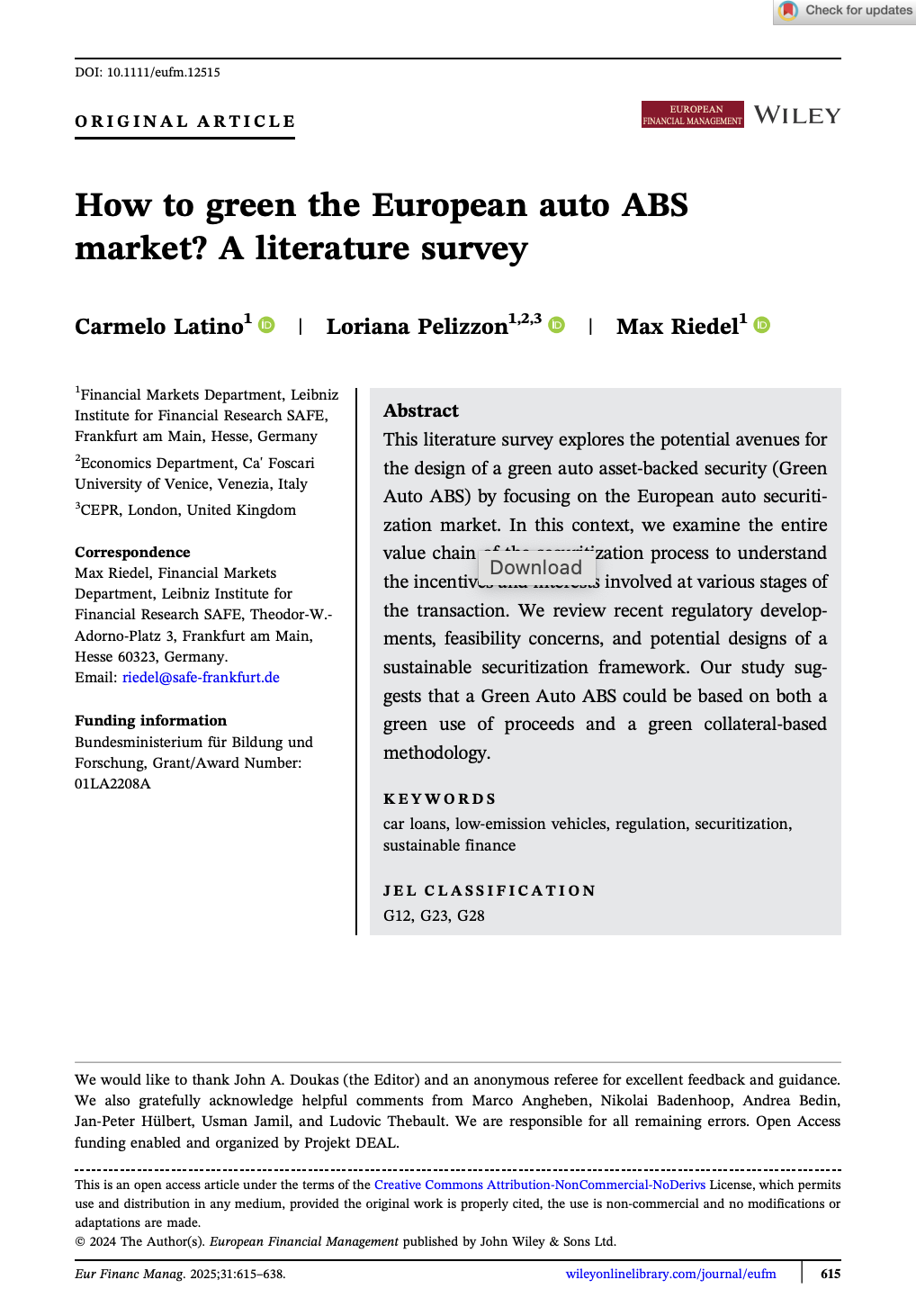
How to Green the European Auto ABS Market? A Literature Survey
This literature survey explores the potential avenues for the design of a green auto asset-backed security (Green Auto ABS) by focusing on the European auto securitization market. In this context, we examine the entire value chain of the securitization process to understand the incentives and interests involved at various stages of the transaction. We review recent regulatory developments, feasibility concerns, and potential designs of a sustainable securitization framework. Our study suggests that a Green Auto ABS could be based on both a green use of proceeds and a green collateral-based methodology.
- Veröffentlichungsdatum: 06.07.2023
- Autor:innen: Carmelo Latino, Loriana Pelizzon & Max Riedel
- Publikationsart: Working Paper
- Link zur Publikation
GAS I Fragmented EU Car Labels: How To Achieve Consumer-Friendly Standardisation and Transparency?
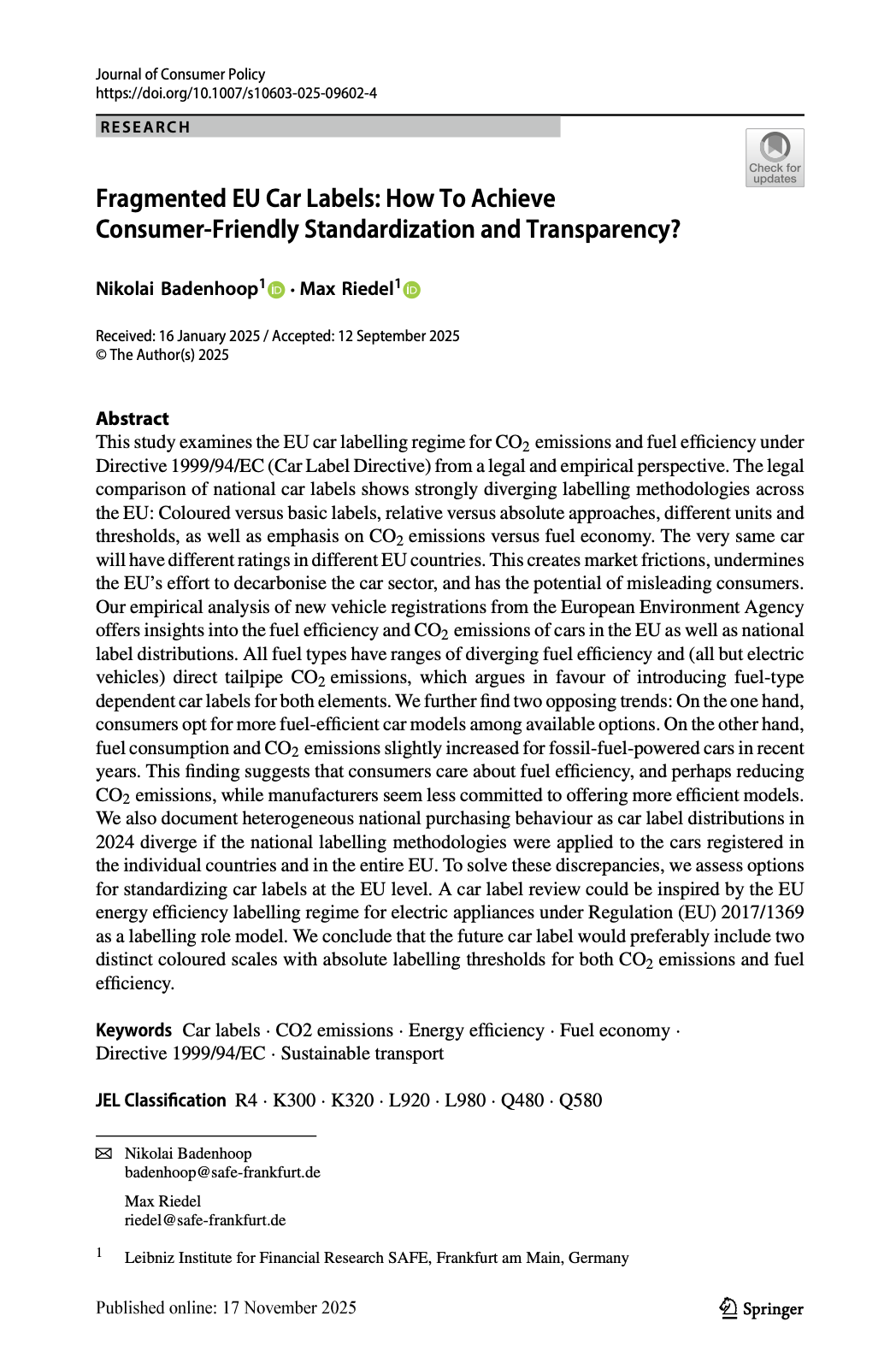
Fragmented EU Car Labels: How To Achieve Consumer-Friendly Standardisation and Transparency?
This study examines the EU car labelling regime for emissions and fuel efficiency under Directive 1999/94/EC (Car Label Directive) from a legal and empirical perspective. The legal comparison of national car labels shows strongly diverging labelling methodologies across the EU: Coloured versus basic labels, relative versus absolute approaches, different units and thresholds, as well as emphasis on emissions versus fuel economy. The very same car will have different ratings in different EU countries. This creates market frictions, undermines the EU’s effort to decarbonise the car sector, and has the potential of misleading consumers. Our empirical analysis of new vehicle registrations from the European Environment Agency offers insights into the fuel efficiency and emissions of cars in the EU as well as national label distributions. All fuel types have ranges of diverging fuel efficiency and (all but electric vehicles) direct tailpipe emissions, which argues in favour of introducing fuel-type dependent car labels for both elements. We further find two opposing trends: On the one hand, consumers opt for more fuel-efficient car models among available options. On the other hand, fuel consumption and emissions slightly increased for fossil-fuel-powered cars in recent years. This finding suggests that consumers care about fuel efficiency, and perhaps reducing emissions, while manufacturers seem less committed to offering more efficient models. We also document heterogeneous national purchasing behaviour as car label distributions in 2024 diverge if the national labelling methodologies were applied to the cars registered in the individual countries and in the entire EU. To solve these discrepancies, we assess options for standardizing car labels at the EU level. A car label review could be inspired by the EU energy efficiency labelling regime for electric appliances under Regulation (EU) 2017/1369 as a labelling role model. We conclude that the future car label would preferably include two distinct coloured scales with absolute labelling thresholds for both emissions and fuel efficiency.
- Veröffentlichungsdatum: 16. Januar 2025
- Autor:innen: Nikolai Badenhoop und Max Riedel
- Publikationsart: Paper
- Link zum PDF-Dokument
GAS I From Deletion to Substitution: A Smart Regulatory Path for EU Securitisation Reform
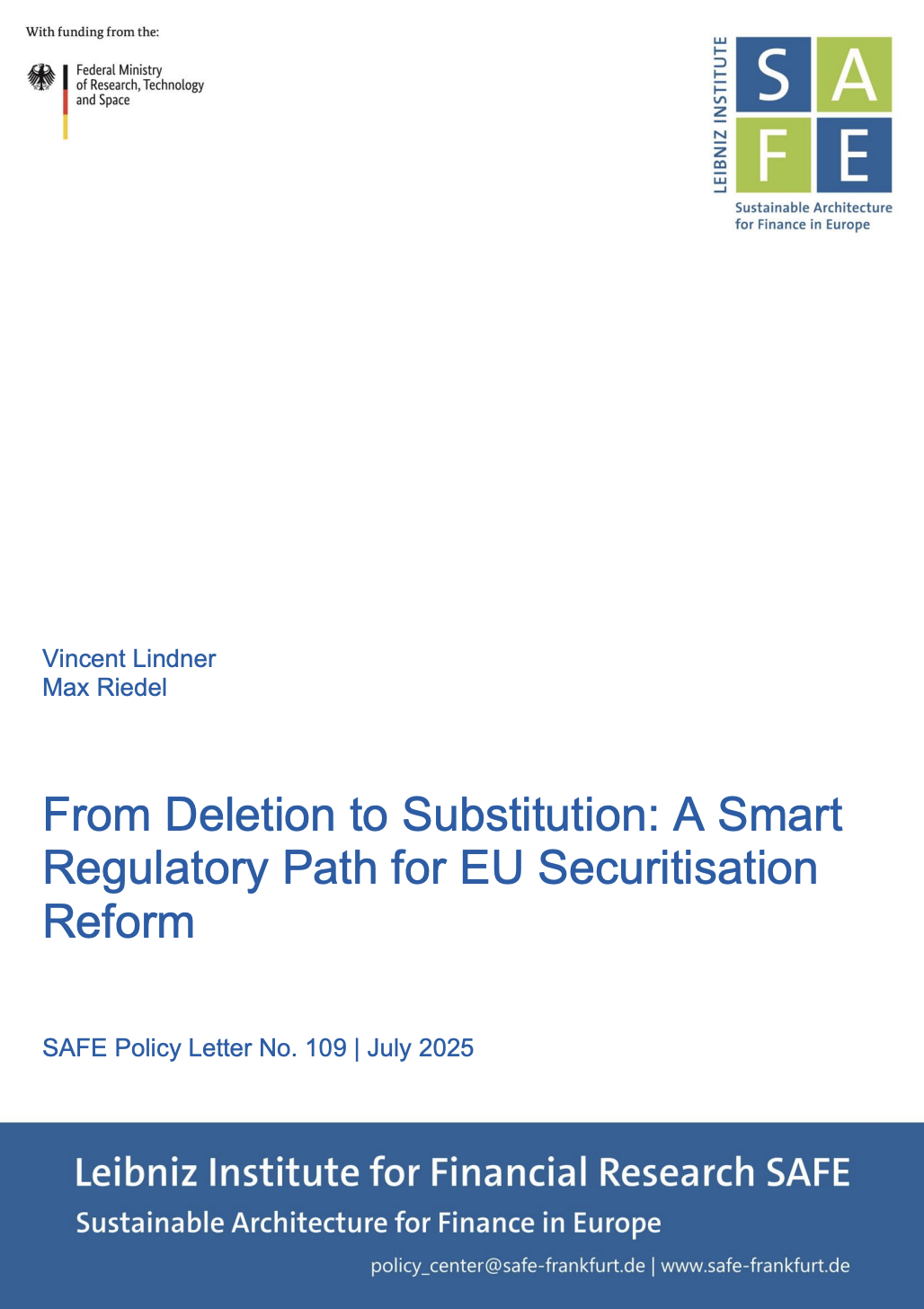
From Deletion to Substitution: A Smart Regulatory Path for EU Securitisation Reform
This policy letter critically assesses the European Commission’s proposed revisions to the Securitisation Regulation, which aim to simplify disclosure requirements by reducing reporting fields by at least 35%. While the Commission frames this as a step toward cutting red tape, this quantitative approach risks undermining the core function of securitisation reporting: to ensure transparency and enable effective risk assessment. We argue that politically expedient deregulation overlooks key qualitative dimensions of financial supervision. Using the case of auto asset-backed securities (ABS), we propose a costeffective alternative that reduces administrative burden while enhancing information depth. Specifically, we demonstrate that the mandatory reporting of just two existing vehicle identifiers can yield highly granular and reliable vehicle data. Using public datasets from the European Environment Agency, we show that these identifiers can reproduce or surpass the current data quality for key vehicle characteristics, including CO₂ emissions, fuel type, and engine power. We conclude that regulatory simplification should aim for intelligent substitution rather than deletion.
- Veröffentlichungsdatum: Juli 2025
- Autor:innen: Vincent Lindner und Max Riedel
- Publikationsart: Policy Letter
- Link zum PDF-Dokument
GAS I Mutual Funds’ Appetite for Sustainability in European Auto ABS

Mutual Funds’ Appetite for Sustainability in European Auto ABS
Using hand-collected data on European auto asset-backed securities (Auto ABS), we examine the role of mutual funds in financing the transition to zero-emission mobility. Mutual funds, particularly those with a green mandate, tend to have a higher exposure to sustainability-transparent Auto ABS and tend to allocate more capital to deals with a higher proportion of electric vehicles. However, we find no clear preference for portfolios with lower average CO2 emissions. This behaviour suggests that, in the absence of a globally recognized framework for green securitizations, asset managers rely on sustainability proxies that are associated with the lowest disclosure processing costs. Our analysis provides important new evidence on how standardized sustainability disclosures at both the prospectus and loan levels could influence asset allocation.
- Veröffentlichungsdatum: 25. April 2025
- Autor:innen: Carmelo Latino, Loriana Pelizzon, Max Riedel und Yue Wang
- Publikationsart: Working Paper
- Link zum PDF-Dokument
GAS I Vehicle identifiers: the key to jumpstarting the European Green Auto ABS market?
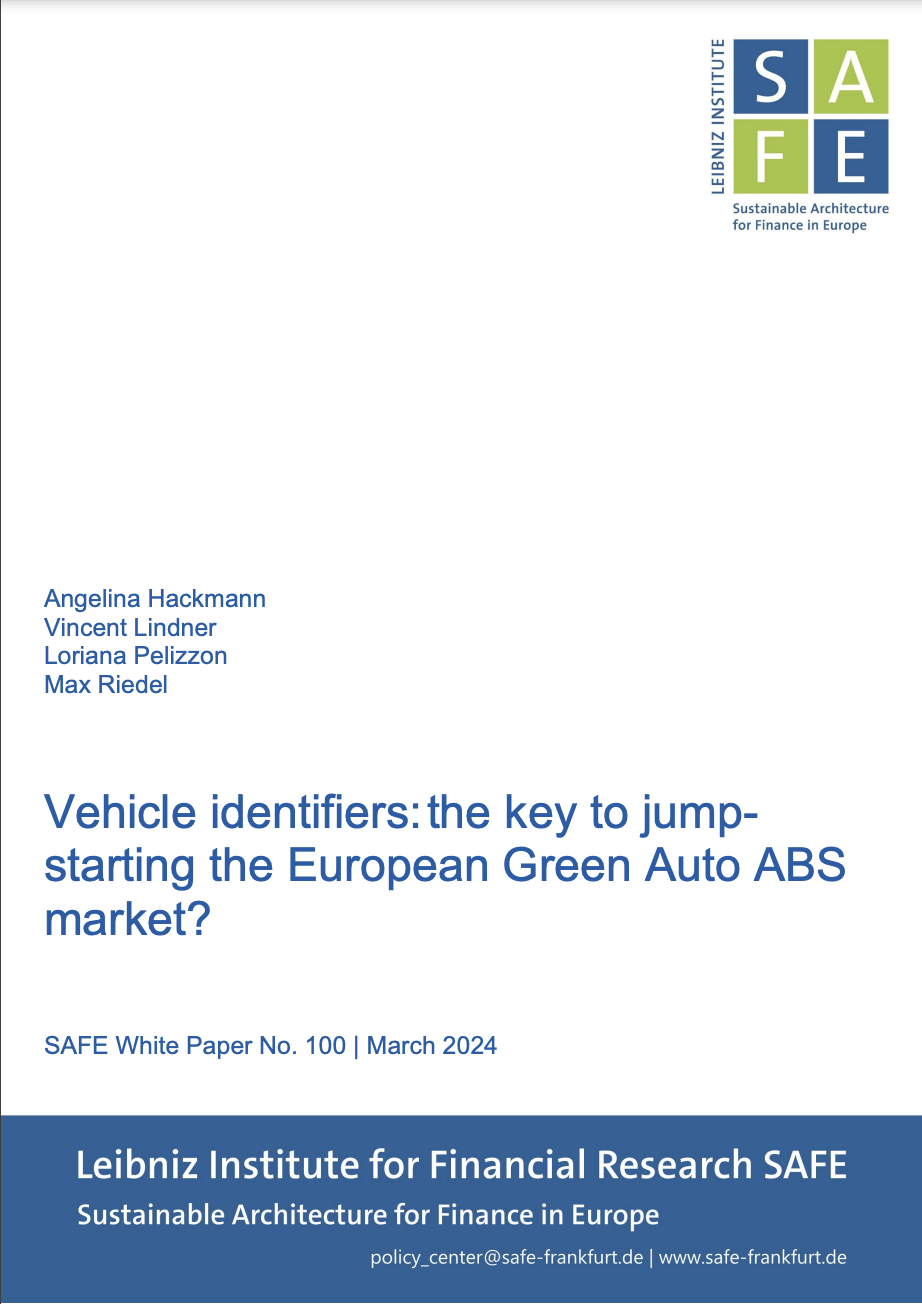
Vehicle identifiers: the key to jumpstarting the European Green Auto ABS market?
This paper addresses the need for transparent sustainability disclosure in the European Auto Asset-Backed Securities (ABS) market, a crucial element in achieving the EU's climate goals. It proposes the use of existing vehicle identifiers, the Type Approval Number (TAN) and the Type-Variant-Version Code (TVV), to integrate loan-level data with sustainability-related vehicle information from ancillary sources. While acknowledging certain challenges, the combined use of TAN and TVV is the optimal solution to allow all stakeholders to comprehensively assess the environmental characteristics of securitised exposure pools in terms of data protection, matching accuracy, and cost-effectiveness.
- Veröffentlichungsdatum: März 2024
- Autor:innen: Angelina Hackmann, Vincent Lindner, Loriana Pelizzon & Max Riedel
- Publikationsart: White Paper
- Link zum PDF-Dokument
INTERACT I Does the European Union need another Green Bond Standard?
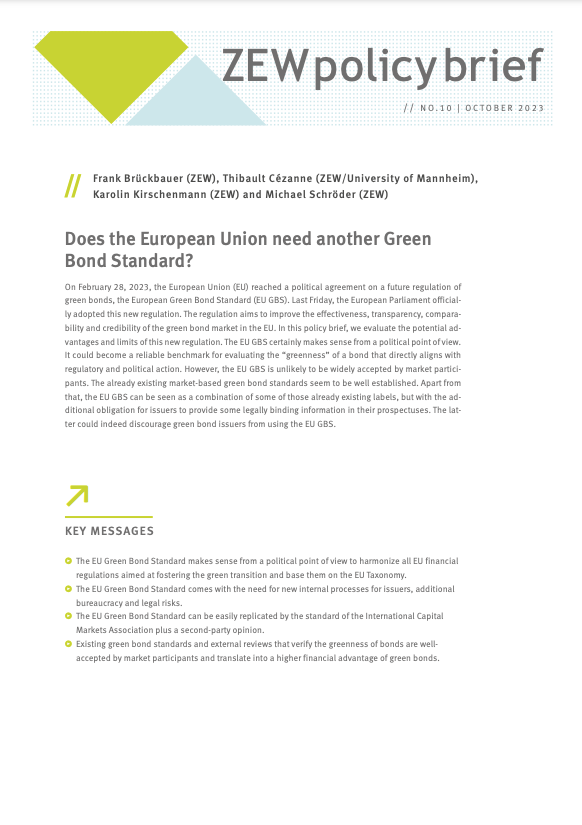
Does the European Union need another Green Bond Standard?
On February 28, 2023, the European Union (EU) reached a political agreement on a future regulation of green bonds, the European Green Bond Standard (EU GBS). Last Friday, the European Parliament officially adopted this new regulation. The regulation aims to improve the effectiveness, transparency, comparability and credibility of the green bond market in the EU. In this policy brief, we evaluate the potential advantages and limits of this new regulation. The EU GBS certainly makes sense from a political point of view. It could become a reliable benchmark for evaluating the “greenness” of a bond that directly aligns with regulatory and political action. However, the EU GBS is unlikely to be widely accepted by market participants. The already existing market-based green bond standards seem to be well established. Apart from that, the EU GBS can be seen as a combination of some of those already existing labels, but with the additional obligation for issuers to provide some legally binding information in their prospectuses. The latter could indeed discourage green bond issuers from using the EU GBS.
- Veröffentlichungsdatum: Oktober 2023
- Autor:innen: Frank Brückbauer, Thibault Cézanne, Karolin Kirschenmann & Michael Schröder
- Publikationsart: Policy Brief
- Link zum PDF-Dokument
INTERACT I The EU Taxonomy’s (Potential) Effects on the Banking Sector and Bank Lending to Firms
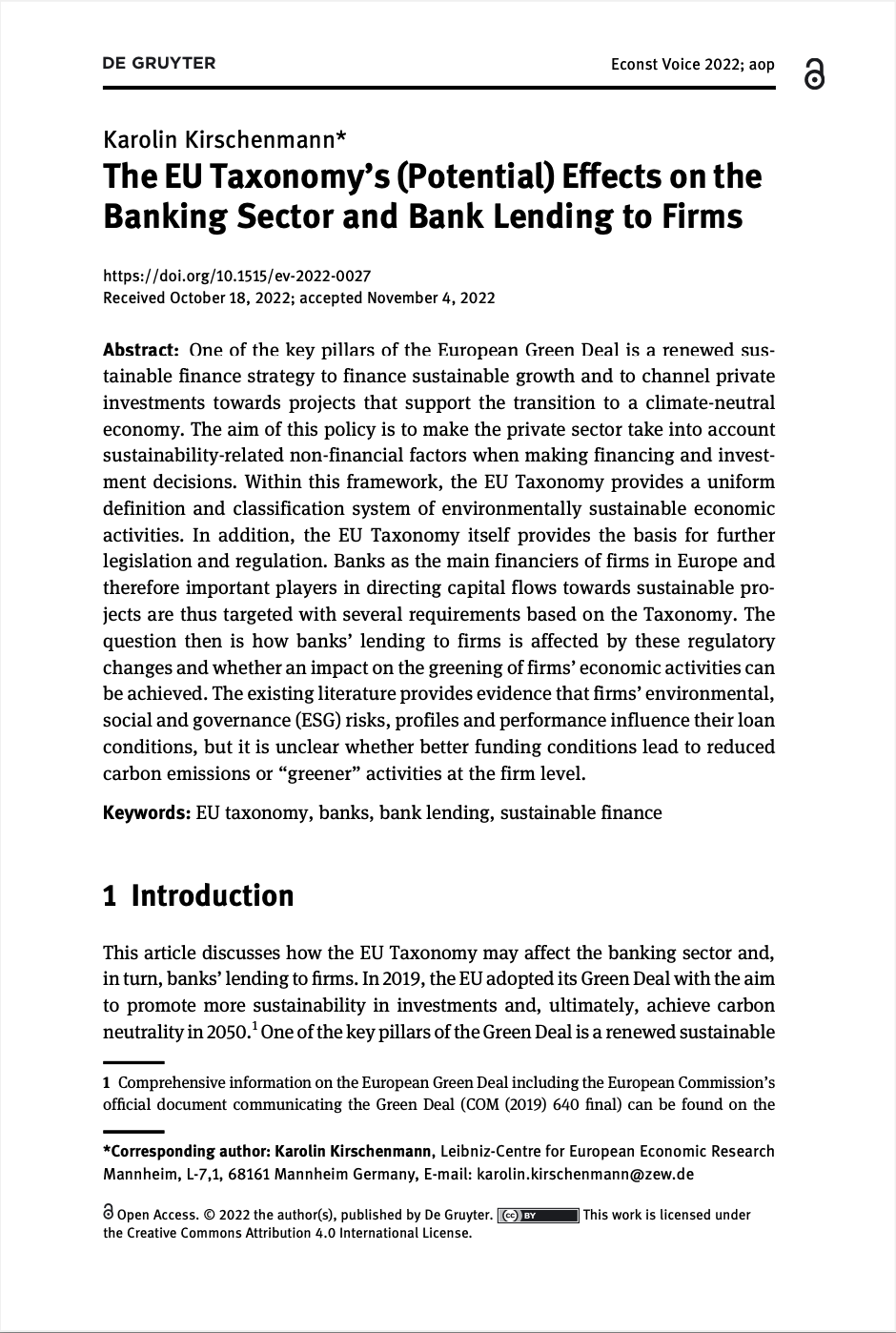
The EU Taxonomy’s (Potential) Effects on the Banking Sector and Bank Lending to Firms
One of the key pillars of the European Green Deal is a renewed sustainable finance strategy to finance sustainable growth and to channel private investments towards projects that support the transition to a climate-neutral economy. The aim of this policy is to make the private sector take into account sustainability-related non-financial factors when making financing and investment decisions. Within this framework, the EU Taxonomy provides a uniform definition and classification system of environmentally sustainable economic activities. In addition, the EU Taxonomy itself provides the basis for further legislation and regulation. Banks as the main financiers of firms in Europe and therefore important players in directing capital flows towards sustainable projects are thus targeted with several requirements based on the Taxonomy. The question then is how banks’ lending to firms is affected by these regulatory changes and whether an impact on the greening of firms’ economic activities can be achieved. The existing literature provides evidence that firms’ environmental, social and governance (ESG) risks, profiles and performance influence their loan conditions, but it is unclear whether better funding conditions lead to reduced carbon emissions or “greener” activities at the firm level.
- Veröffentlichungsdatum: 04.11.2022
- Autor:innen: Karolin Kirschenmann
- Publikationsart: Paper
- Link zum PDF-Dokument
KliK I Praxisleitfaden: Nachhaltigkeitsberichterstattung für KMU

Praxisleitfaden: Nachhaltigkeitsberichterstattung für KMU
Nachhaltigkeit spielt zunehmend eine Schlüsselrolle in der Weiterentwicklung unternehmerischer Geschäftsmodelle. Auch für kleine und mittlere Unternehmen (KMU) in Deutschland ist nachhaltiges Wirtschaften längst ein wichtiger Wettbewerbsfaktor. Das Nachhaltigkeitsmanagement, verstanden als ein auf langfristige Wirtschaftlichkeit, soziale Gerechtigkeit und den Erhalt der Umwelt ausgerichtetes Vorgehen, entwickelt sich zu einem wesentlichen Bestandteil einer leistungsstarken Unternehmensstrategie. Die sich rasch ändernden gesetzlichen Rahmenbedingungen unterstreichen, dass es für Unternehmen zwingend notwendig ist, sich noch intensiver mit den Anforderungen an ein unternehmerisches Nachhaltigkeitsmanagement auseinanderzusetzen. Besonders greifbar ist dieser Druck an den verschiedenen umfassenden Pflichten zur Nachhaltigkeitsberichterstattung, die schrittweise sowohl den Kreis an berichtspflichtigen Unternehmen als auch den Umfang der zu berichtenden nichtfinanziellen Informationen erheblich ausweiten. Der steigende Bedarf nach Wissen und Anleitung in der Berichterstattung und im Nachhaltigkeitsmanagement erfasst auch KMU, die entweder direkt von den gesetzlichen Regelungen betroffen oder indirekt durch ihre Geschäftspartner in der Lieferkette zur Umsetzung entsprechender Maßnahmen aufgefordert sind. Unter dem Leitthema des Bürokratieabbaus und dem Wunsch nach einer Stärkung der Wettbewerbsfähigkeit sind zwar aktuell auf der europäischen Ebene Bestrebungen zu erkennen, die Berichtspflichten zu vereinfachen. Aber unabhängig von den Ergebnissen dieser politischen Diskussion sind KMU gut beraten, sich rechtzeitig mit den neuen Gesetzen auseinanderzusetzen bzw. ihre bereits begonnenen Anstrengungen fortzuführen und etwaige Lücken zu schließen. KMU haben gute Voraussetzungen, um flexibel und innovativ zu handeln und ihre ökonomischen Ziele im Einklang mit ökologischer und sozialer Verantwortung zu erreichen. Der vorliegende Praxisleitfaden soll kleine und mittlere Unternehmen bei der Bewältigung der damit einhergehenden Herausforderungen unterstützen und ihnen helfen, die sich ergebenden Chancen zu nutzen. Der Leitfaden zeigt auf, wie ausgehend von einer institutionellen Einordnung und einem fundierten Begriffsverständnis zentrale Elemente einer Nachhaltigkeitsstrategie abgeleitet werden können. Im Fokus des Leitfadens steht die Nachhaltigkeitsberichterstattung nach der Corporate Sustainability Reporting Directive (CSRD) mit den neu eingeführten European Sustainability Reporting Standards (ESRS), so dass die wesentlichen Schritte bei der Erstellung eines Nachhaltigkeitsberichts erfasst und Informationspflichten, wie sie beispielsweise im Rahmen des Kreditprozesses auftreten, erfüllt werden können.
- Veröffentlichungsdatum: Februar 2025
- Autor:innen: Jörgen Eimecke, Jan Heldmann, Prof. Dr. Torsten Kühlmann, Katharina Hereth, Dr.-Ing. Fatah Naji, Prof. Dr. Nadine Warkotsch, Alexander-Michael Gerk, Andreas Horn & Prof. Dr. Klaus Schäfer
- Publikationsart: Praxisleitfaden
- Link zum PDF-Dokument
KliK I Sustainability in the German economy – A comparison of understanding, measures and reporting between SMEs and large companies

Sustainability in the German economy – A comparison of understanding, measures and reporting between SMEs and large companies
Sustainability and non-financial risk management are becoming increasingly important for German companies due to climate change and new regulations. However, it is unclear how well companies of varying sizes are prepared to handle the increasing pressure to adapt. While large companies are obliged to publish a sustainability report due to regulatory requirements such as the CSRD, there is no direct obligation for SMEs. Nevertheless, due to external pressure from stakeholders and information requirements of large companies, SMEs increasingly have to address the issue of sustainability. This raises the question as to how far large companies and SMEs have progressed in implementing sustainability, how the costs and benefits of this adaptation process can be compared and what differences can be identified between the two company sizes. Our study is based on a June 2023 survey of 120 companies and provides an overview of the current state of sustainability management in German companies. Further, our results show that large companies have a broader understanding of sustainability than SMEs. In addition, most large companies already implement and report on sustainability measures. Overall, we observe that there is a link between understanding sustainability, implementing sustainability measures and sustainability reporting.
- Veröffentlichungsdatum: Oktober 2025
- Autor:innen: Andreas Horn, Ruth Berkmüller, Monika Bokelmann, Alexander-Michael Gerk, Jan Heldmann, Miriam Knauer, Fatah Naji, Simon Rath, Franziska Sperling und Johanna Wagner
- Publikationsart: Working Paper
- Link zum PDF-Dokument
KlimKomInvest I Sustainable Finance für Kommunen
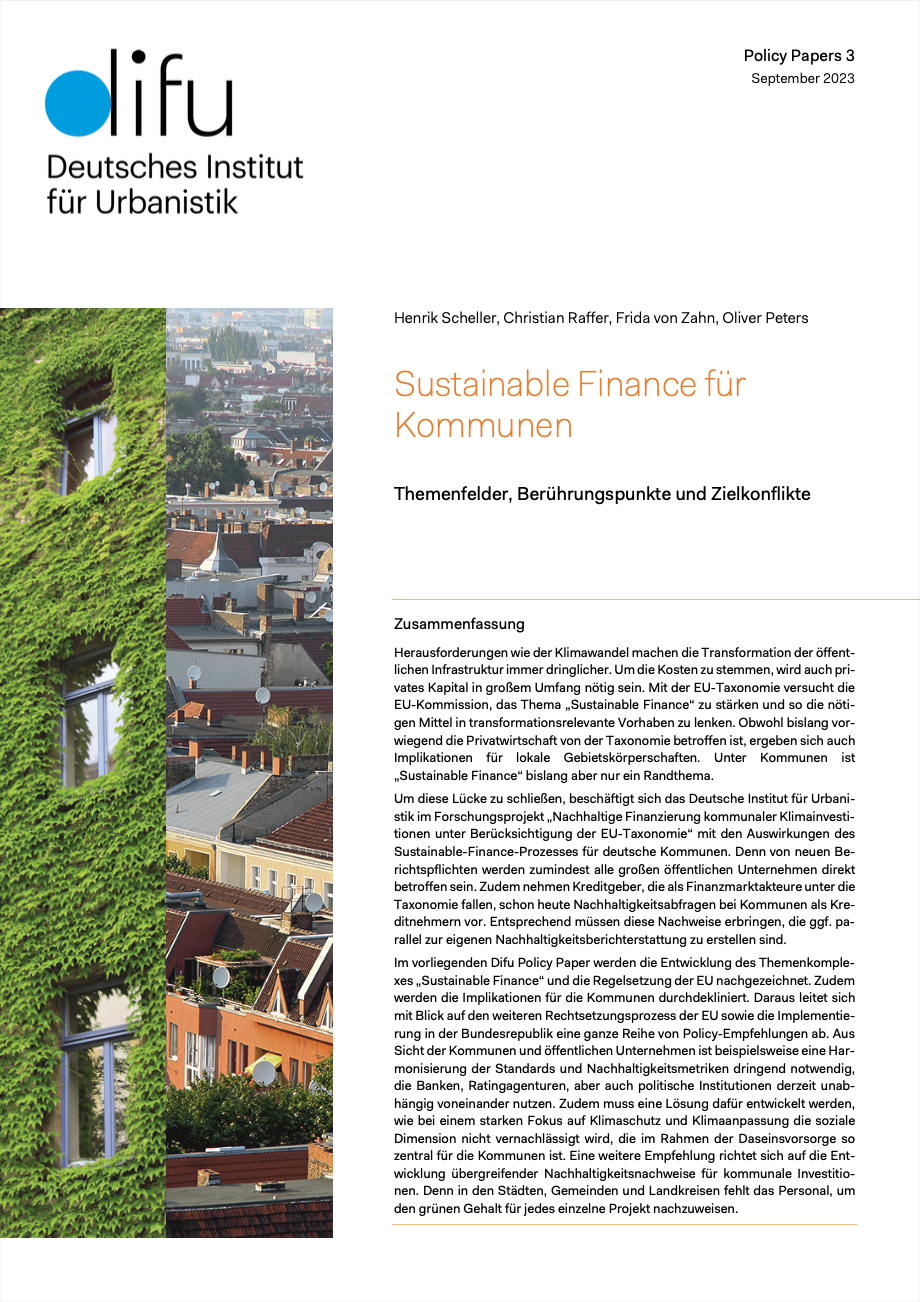
Sustainable Finance für Kommunen - Themenfelder, Berührungspunkte und Zielkonflikte
Herausforderungen wie der Klimawandel machen die Transformation der öffentlichen Infrastruktur immer dringlicher. Um die Kosten zu stemmen, wird auch privates Kapital in großem Umfang nötig sein. Mit der EU-Taxonomie versucht die EU-Kommission, das Thema „Sustainable Finance“ zu stärken und so die nötigen Mittel in transformationsrelevante Vorhaben zu lenken. Obwohl bislang vorwiegend die Privatwirtschaft von der Taxonomie betroffen ist, ergeben sich auch Implikationen für lokale Gebietskörperschaften. Unter Kommunen ist „Sustainable Finance“ bislang aber nur ein Randthema. Um diese Lücke zu schließen, beschäftigt sich das Deutsche Institut für Urbanistik im Forschungsprojekt „Nachhaltige Finanzierung kommunaler Klimainvestitionen unter Berücksichtigung der EU-Taxonomie“ mit den Auswirkungen des Sustainable-Finance-Prozesses für deutsche Kommunen. Denn von neuen Berichtspflichten werden zumindest alle großen öffentlichen Unternehmen direkt betroffen sein. Zudem nehmen Kreditgeber, die als Finanzmarktakteure unter die Taxonomie fallen, schon heute Nachhaltigkeitsabfragen bei Kommunen als Kreditnehmern vor. Entsprechend müssen diese Nachweise erbringen, die ggf. parallel zur eigenen Nachhaltigkeitsberichterstattung zu erstellen sind. Im vorliegenden Difu Policy Paper werden die Entwicklung des Themenkomplexes „Sustainable Finance“ und die Regelsetzung der EU nachgezeichnet. Zudem werden die Implikationen für die Kommunen durchdekliniert. Daraus leitet sich mit Blick auf den weiteren Rechtsetzungsprozess der EU sowie die Implementierung in der Bundesrepublik eine ganze Reihe von Policy-Empfehlungen ab. Aus Sicht der Kommunen und öffentlichen Unternehmen ist beispielsweise eine Harmonisierung der Standards und Nachhaltigkeitsmetriken dringend notwendig, die Banken, Ratingagenturen, aber auch politische Institutionen derzeit unabhängig voneinander nutzen. Zudem muss eine Lösung dafür entwickelt werden, wie bei einem starken Fokus auf Klimaschutz und Klimaanpassung die soziale Dimension nicht vernachlässigt wird, die im Rahmen der Daseinsvorsorge so zentral für die Kommunen ist. Eine weitere Empfehlung richtet sich auf die Entwicklung übergreifender Nachhaltigkeitsnachweise für kommunale Investitionen. Denn in den Städten, Gemeinden und Landkreisen fehlt das Personal, um den grünen Gehalt für jedes einzelne Projekt nachzuweisen.
- Veröffentlichungsdatum: September 2023
- Autor:innen: Henrik Scheller, Christian Raffer, Frida von Zahn & Oliver Peters
- Publikationsart: Policy Paper
- Link zum PDF-Dokument
KlimKomInvest I Sustainable Finance und die öffentliche Finanz- und Haushaltswirtschaft der Kommunen
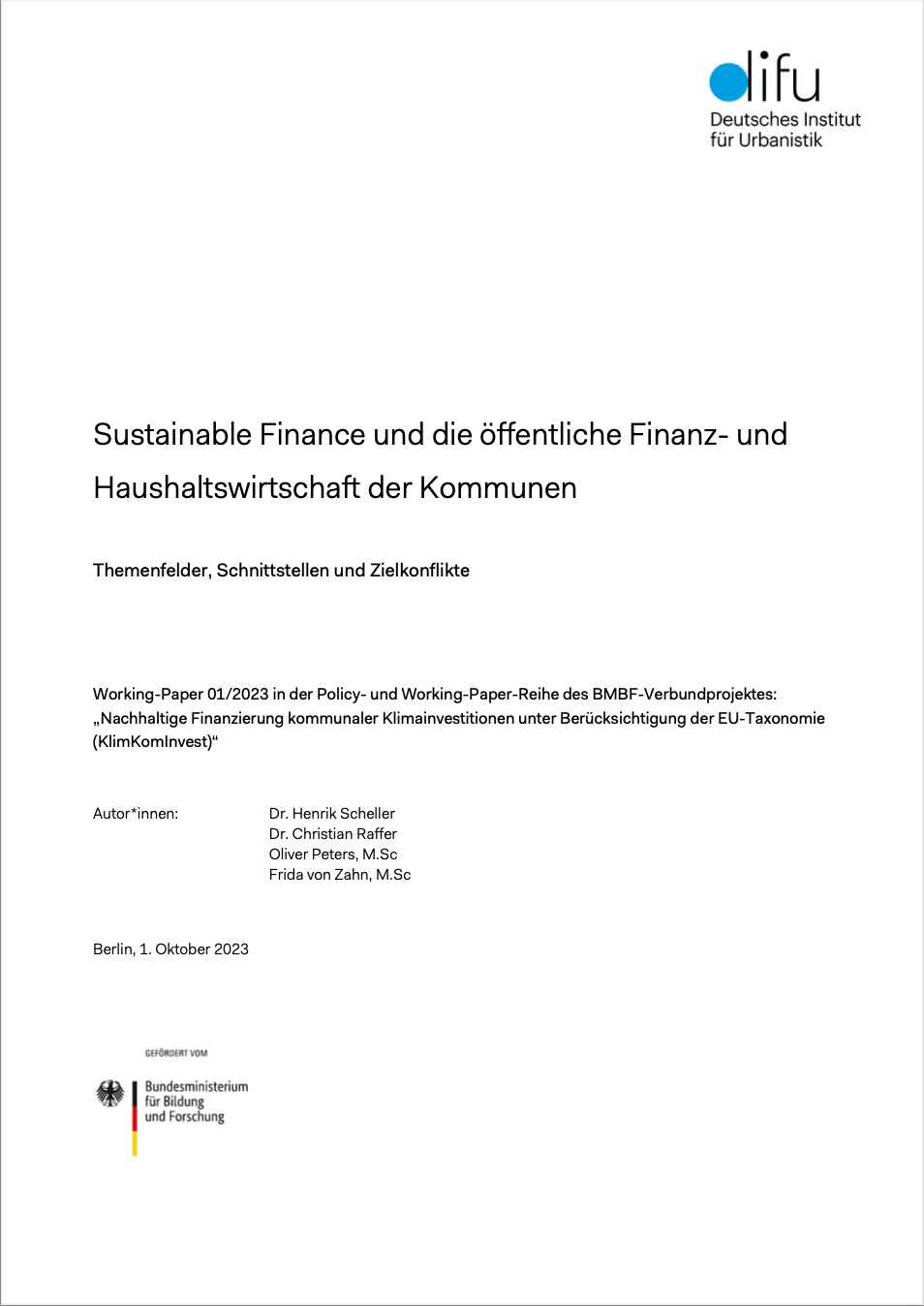
Sustainable Finance und die öffentliche Finanz- und Haushaltswirtschaft der Kommunen
Herausforderungen wie der Klimawandel machen die Transformation der öffentlichen Infrastruktur immer dringlicher. Um diese Kosten zu stemmen, wird auch privates Kapital in großem Umfang nötig sein. Mit der EU-Taxonomie versucht die EU-Kommission, das Thema „Sustainable Finance“ zu stärken und so die nötigen Mittel in transformationsrelevante Vorhaben zu lenken. Obwohl bislang vorwiegend die Privatwirtschaft von der Taxonomie betroffen ist, ergeben sich auch Implikationen für locale Gebietskörperschaften. Unter Kommunen ist „Sustainable Finance“ bislang aber nur ein Randthema. Um diese Lücke zu schließen, beschäftigt sich das Deutsche Institut für Urbanistik im Forschungsprojekt „Nachhaltige Finanzierung kommunaler Klimainvestitionen unter Berücksichtigung der EU-Taxonomie“ mit den möglichen Auswirkungen des Sustainable-Finance-Prozesses für deutsche Kommunen. Denn von neuen Berichtspflichten werden zumindest alle großen öffentlichen Unternehmen direct betroffen sein. Zudem nehmen Kreditgeber, die als Finanzmarktakteure unter die Taxonomie fallen, schon heute Nachhaltigkeitsabfragen bei Kommunen als Kreditnehmern vor. Entsprechend müssen diese Nachweise erbringen, die ggf. parallel zur eigenen Nachhaltigkeitsberichterstattung zu erstellen sind. Im vorliegenden Difu-Policy-Paper werden die Entwicklung des Themenkomplexes „Sustainable Finance“ und die Regelsetzung der EU nachgezeichnet. Zudem werden die Implikationen für die Kommunen durchdekliniert. Daraus werden mit Blick auf den weiteren Rechtsetzungsprozess der EU sowie die Implementierung in der Bundesrepublik folgende Policy-Empfehlungen abgeleitet.
- Veröffentlichungsdatum: 01.10.2023
- Autor:innen: Henrik Scheller, Christian Raffer, Oliver Peters & Frida von Zahn
- Publikationsart: Working Paper
- Link zum PDF-Dokument
SATISFY I Are sustainability-linked loans designed to effectively incentivize corporate sustainability? A framework for review
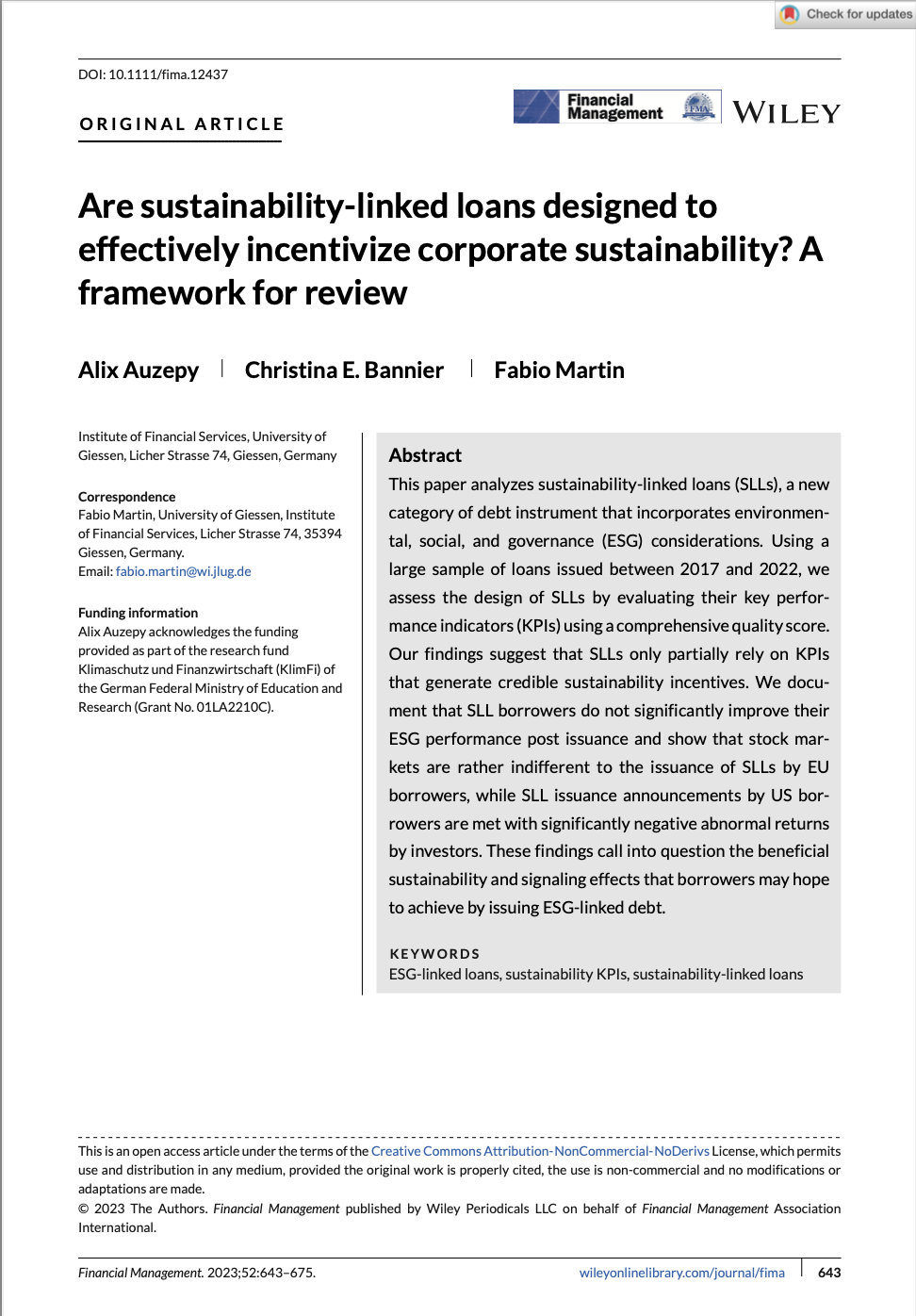
Are sustainability-linked loans designed to effectively incentivize corporate sustainability? A framework for review
This paper analyzes sustainability-linked loans (SLLs), a new category of debt instrument that incorporates environmen- tal, social, and governance (ESG) considerations. Using a large sample of loans issued between 2017 and 2022, we assess the design of SLLs by evaluating their key perfor- mance indicators (KPIs) using a comprehensive quality score. Our findings suggest that SLLs only partially rely on KPIs that generate credible sustainability incentives. We docu- ment that SLL borrowers do not significantly improve their ESG performance post issuance and show that stock mar- kets are rather indifferent to the issuance of SLLs by EU borrowers, while SLL issuance announcements by US bor- rowers are met with significantly negative abnormal returns by investors. These findings call into question the beneficial sustainability and signaling effects that borrowers may hope to achieve by issuing ESG-linked debt.
- Veröffentlichungsdatum: 03.10.2023
- Autor:innen: Alix Auzepy, Christina E. Bannier & Fabio Martin
- Publikationsart: Article
- Link zum PDF-Dokument
SATISFY I Climate scenarios in banks – a case study

Integrating Climate Risks in Bank Risk Management and Capital Requirements
This work aims to provide a detailed analysis of institutional practices and regulatory developments that we hope will be of value to academics, industry practitioners and policymakers engaged in this feld. By presenting concrete examples of approaches used by large credit institutions in the European Union, enriched with insights from risk experts, our study also provides guidance for the climate risk integration eforts of smaller credit institutions that may be in the early stages of their “journey”. Importantly, this work aims to paint an objective picture of current developments and does not advocate for a particular policy stance. As this book is the result of an extensive research project, its structure is similar to that of a research paper, including a comprehensive discussion of the theoretical background, covering key regulatory and supervisory developments, and a short literature review describing the empirical evidence on the growing relevance of climate risks for fnancial institutions and supervisors. Before presenting the results, a methodology section outlines the empirical approach and the conceptual framework that guides our analysis. We conclude with a discussion of limitations and recommendations for further research and policy initiatives.
- Veröffentlichungsdatum: 2025
- Autor:innen: Alix Auzepy, Christina E. bannier
- Publikationsart: Book
- Link zum PDF-Dokument
SATISFY I European corporate sustainability reporting - The Financial Materiality Compass as an auxiliary tool
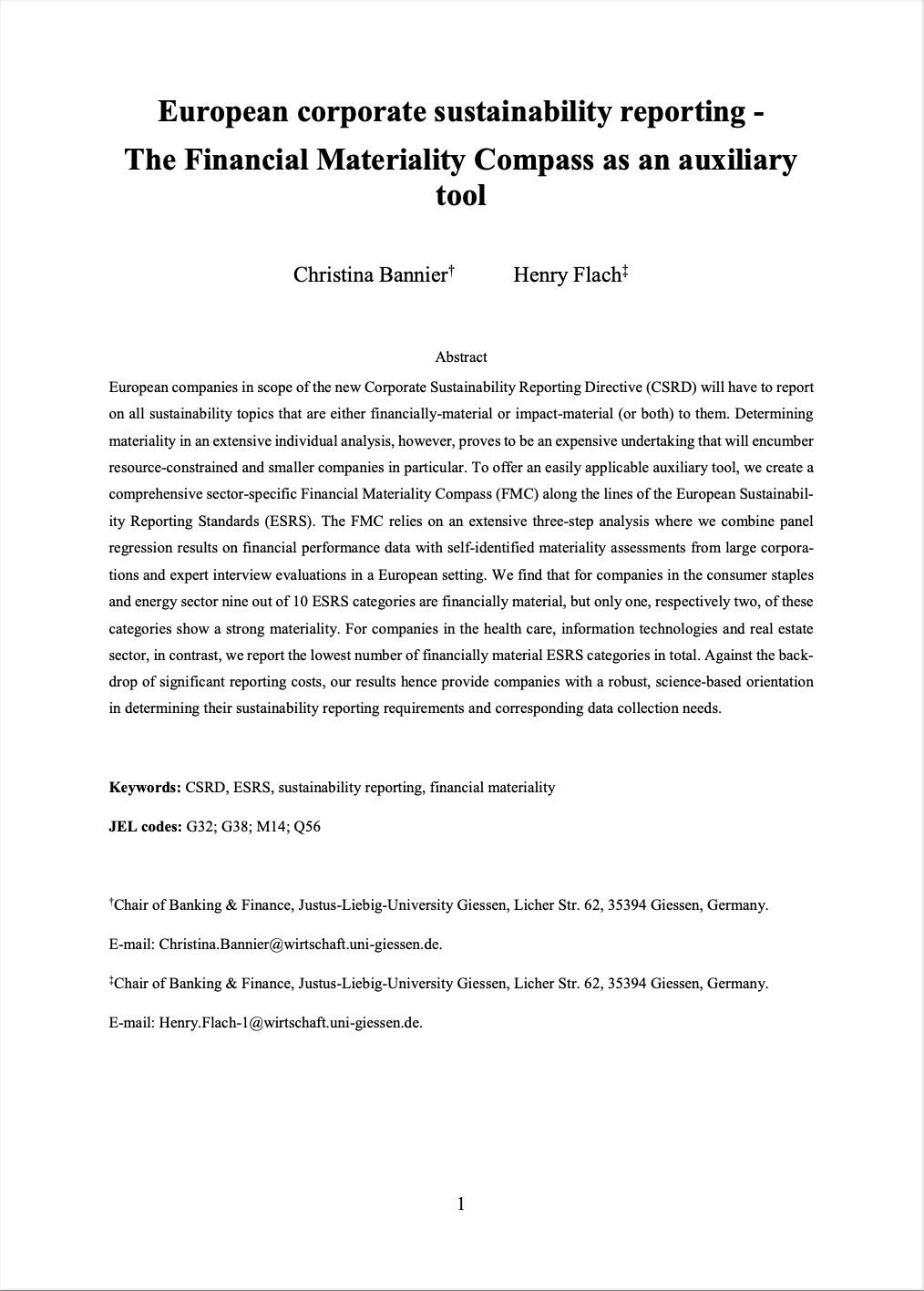
European corporate sustainability reporting - The Financial Materiality Compass as an auxiliary tool
European companies in scope of the new Corporate Sustainability Reporting Directive (CSRD) will have to report on all sustainability topics that are either financially-material or impact-material (or both) to them. Determining materiality in an extensive individual analysis, however, proves to be an expensive undertaking that will encumber resource-constrained and smaller companies in particular. To offer an easily applicable auxiliary tool, we create a comprehensive sector-specific Financial Materiality Compass (FMC) along the lines of the European Sustainabil-ity Reporting Standards (ESRS). The FMC relies on an extensive three-step analysis where we combine panel regression results on financial performance data with self-identified materiality assessments from large corpora-tions and expert interview evaluations in a European setting. We find that for companies in the consumer staples and energy sector nine out of 10 ESRS categories are financially material, but only one, respectively two, of these categories show a strong materiality. For companies in the health care, information technologies and real estate sector, in contrast, we report the lowest number of financially material ESRS categories in total. Against the back-drop of significant reporting costs, our results hence provide companies with a robust, science-based orientation in determining their sustainability reporting requirements and corresponding data collection needs.
- Veröffentlichungsdatum: 08.02.2024
- Autor:innen: Christina Bannier & Henry Flach
- Publikationsart: Paper
- Link zum PDF-Dokument
SATISFY I Evaluating TCFD reporting - A new application of zero-shot analysis to climate-related financial disclosures
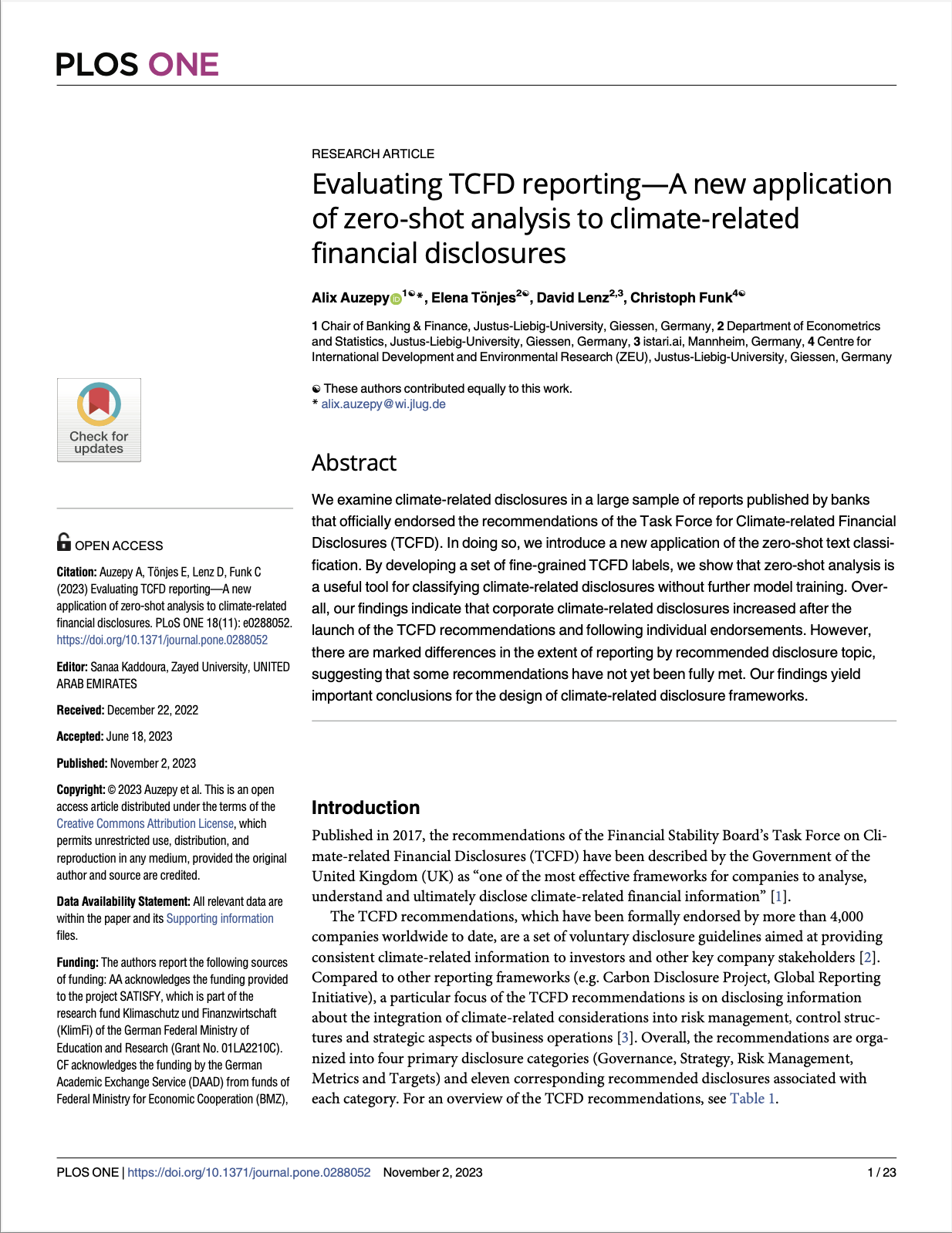
Evaluating TCFD reporting—A new application of zero-shot analysis to climate-related financial disclosures
We examine climate-related disclosures in a large sample of reports published by banks that officially endorsed the recommendations of the Task Force for Climate-related Financial Disclosures (TCFD). In doing so, we introduce a new application of the zero-shot text classification. By developing a set of fine-grained TCFD labels, we show that zero-shot analysis is a useful tool for classifying climate-related disclosures without further model training. Overall, our findings indicate that corporate climate-related disclosures increased after the launch of the TCFD recommendations and following individual endorsements. However, there are marked differences in the extent of reporting by recommended disclosure topic, suggesting that some recommendations have not yet been fully met. Our findings yield important conclusions for the design of climate-related disclosure frameworks.
- Veröffentlichungsdatum: 02.11.2023
- Autor:innen: Alix Auzepy, Elena Tönjes David Lenz & Christoph Funk
- Publikationsart: Research Article
- Link zum PDF-Dokument
SATISFY I Integrating Climate Risks in Bank Risk Management and Capital Requirements

Evaluating TCFD reporting—A new application of zero-shot analysis to climate-related financial disclosures
We examine climate-related disclosures in a large sample of reports published by banks that officially endorsed the recommendations of the Task Force for Climate-related Financial Disclosures (TCFD). In doing so, we introduce a new application of the zero-shot text classification. By developing a set of fine-grained TCFD labels, we show that zero-shot analysis is a useful tool for classifying climate-related disclosures without further model training. Overall, our findings indicate that corporate climate-related disclosures increased after the launch of the TCFD recommendations and following individual endorsements. However, there are marked differences in the extent of reporting by recommended disclosure topic, suggesting that some recommendations have not yet been fully met. Our findings yield important conclusions for the design of climate-related disclosure frameworks.
- Veröffentlichungsdatum: 02.11.2023
- Autor:innen: Alix Auzepy, Elena Tönjes David Lenz & Christoph Funk
- Publikationsart: Research Article
- Link zum PDF-Dokument
SATISFY I Scenario Analysis for Net Zero: The Applicability of Climate Neutrality Studies for Transitioning Firms in the German Building Sector and Energy-intensive Industry

Sustainable Small Business Lending
Banks are the main source of external funding for small businesses. Thus, integrating sustainability considerations in small business lending can support global sustainability efforts. In surveying German banks, I show that banks are in the process of implementing sustainable small business lending. They put more emphasis on sustainability risks than on the transformation of the business model among small businesses. Sustainable relationship lending has some relevance in creating sustainability-related soft information, although respective hard information is preferred by banks. Banks and policymakers can use the findings to better apply sustainable small business lending to sustainability and resilience efforts.
- Veröffentlichungsdatum: Dezember 2024
- Autor:innen: Sebastian Rink
- Publikationsart: Paper
- Keywords: Climate Change, Scenarios Analysis, Decarbonization, Sustainability Reporting, Transition Plans, Sectoral Pathways
- Link zum PDF-Dokument
SATISFY I Sustainable Small Business Lending
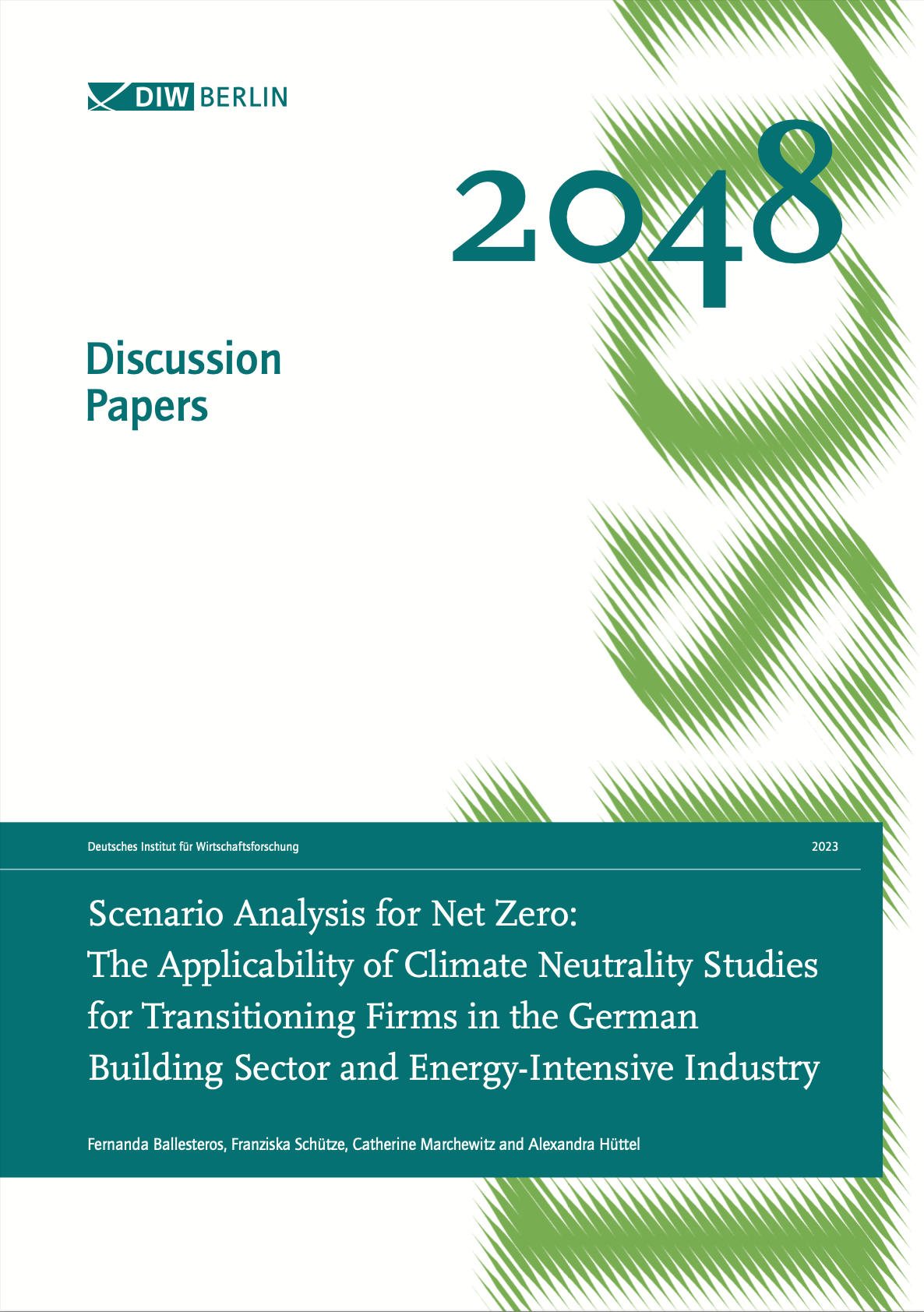
Scenario Analysis for Net Zero: The Applicability of Climate Neutrality Studies for Transitioning Firms in the German Building Sector and Energy-intensive Industry
Various stakeholders are increasingly encouraging companies from the real economy to adopt measures facilitating their transition towards carbon neutrality. In this context, companies are expected to implement forward-looking strategies and climate-related reporting practices using scenario analysis aligned with scientific evidence and credible pathways to net zero carbon emissions. This paper examines the potential of scenario analysis as an element for transitioning to net zero. We review and compare eight existing economy and sector level climate neutrality studies for Germany that were published between 2019 and 2021, analysing their respective applicability as a science-based reference scenario for companies to strengthen strategy development and forward-looking reporting practices. Using the logical framework approach, we assess relevant transition indicators like technologies, energy and resource efficiency, carbon pricing, and other steering instruments for the building and energy-intensive industry sectors. These indicators measure progress towards climate neutrality and could be included as a crucial component in transition plans. We find that, although modelling approaches for the studies differ, they often converge on similar results that can partially be translated to indicators at the firm level and, thereby, may serve as reference scenarios for their transition planning.
- Veröffentlichungsdatum: 2023 (Revised version – 15 January 2025)
- Autor:innen: Fernanda Ballesteros, Franziska Schütze, Catherine Marchewitz & Alexandra Hüttel
- Publikationsart: Discussion Paper
- Keywords: Climate Change, Scenarios Analysis, Decarbonization, Sustainability Reporting, Transition Plans, Sectoral Pathways
- Link zum PDF-Dokument
SuFi I Die grüne Transformation finanzieren: Bankfähigkeit erhöhen, aus klimaschädlichen Investitionen aussteigen, nicht bankfähige Aktivitäten finanzieren
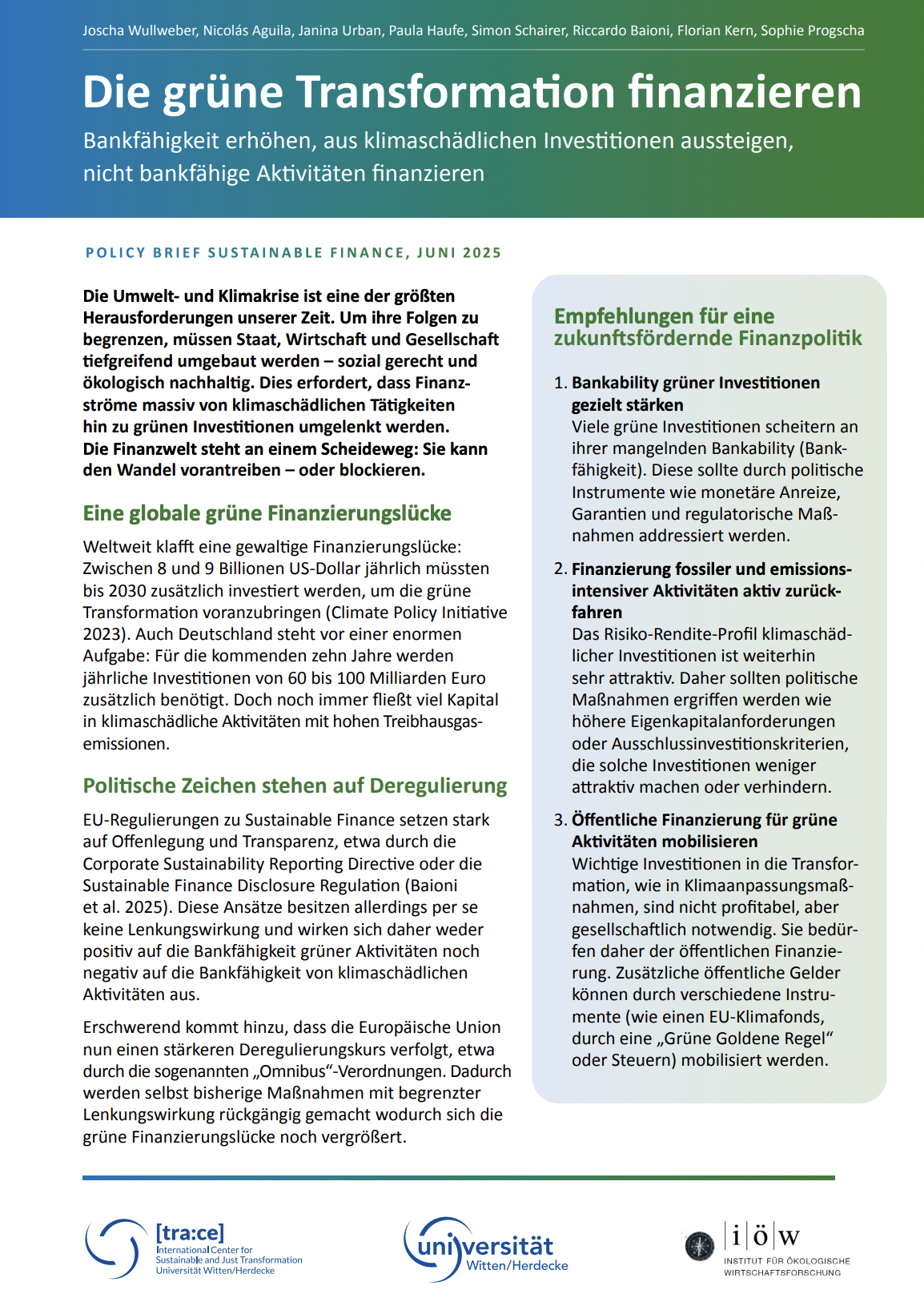
Die grüne Transformation finanzieren Bankfähigkeit erhöhen, aus klimaschädlichen Investitionen aussteigen, nicht bankfähige Aktivitäten finanzieren
Die Umwelt- und Klimakrise ist eine der größten Herausforderungen unserer Zeit. Um ihre Folgen zu begrenzen, müssen Staat, Wirtschaft und Gesellschaft tiefgreifend umgebaut werden – sozial gerecht und ökologisch nachhaltig. Dies erfordert, dass Finanzströme massiv von klimaschädlichen Tätigkeiten hin zu grünen Investitionen umgelenkt werden. Die Finanzwelt steht an einem Scheideweg: Sie kann den Wandel vorantreiben – oder blockieren.
- Veröffentlichungsdatum: Juni 2025
- Autor:innen: Joscha Wullweber, Nicolás Aguila, Janina Urban, Paula Haufe, Simon Schairer, Riccardo Baioni, Florian Kern, Sophie Progscha
- Publikationsart: Policy Brief
- Link zum PDF-Dokument
SuFi I Climate-Related Risk Taking, Shaping and Shifting: How Private Financial Actors Keep Stranded Assets Afloat
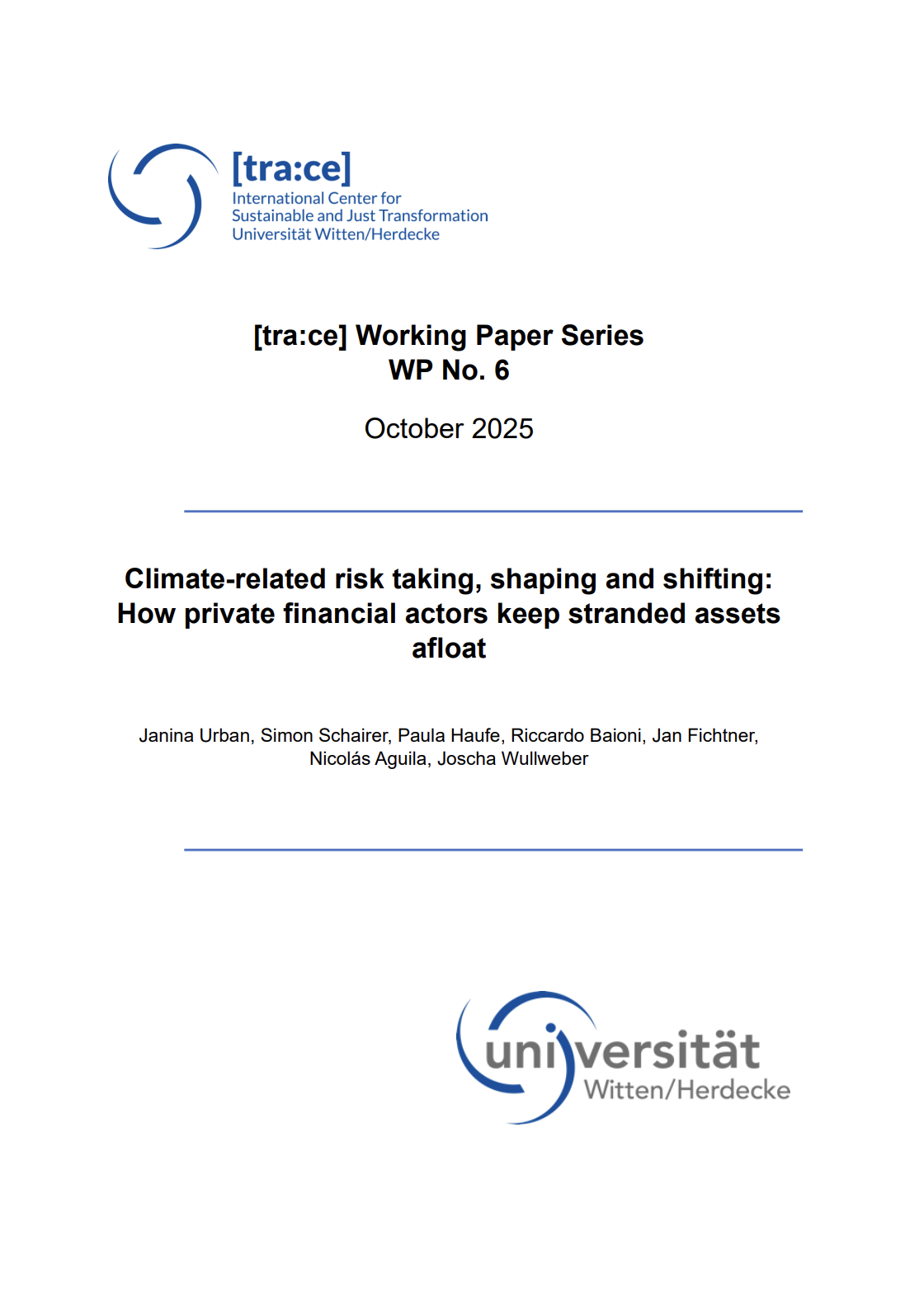
Climate-Related Risk Taking, Shaping and Shifting: How Private Financial Actors Keep Stranded Assets Afloat
European financial institutions face mixed signals on how to account for climaterelated and environmental risks that could prevent a disorderly stranding of assets. The literature has emphasised the financial industry’s inability to cope with the fundamental uncertainty inherent to climate change, but still lacks an analysis of its strategic behaviour in relation to stranded asset risks. Based on the analysis of 38 semi-structured interviews with financial institutions, foremost institutional investors and banks, we address this lacuna. We argue that financial actors primarily employ three strategy clusters to address stranded asset risks: (1) risk taking, (2) risk shaping, and (3) risk shifting. These strategies entail different financial practices and narratives that either imply marginal financially material action, that challenge the scope of stranded assets, or hedge against stranded asset risks. We argue that drawing on these strategies enables financial institutions to keep stranded assets afloat rather than orchestrating a collective phase-out.
- Veröffentlichungsdatum: Oktober 2025
- Autor:innen: Janina Urban, Simon Schairer, Paula Haufe, Riccardo Baioni, Jan Fichtner, Nicolás Aguila, Joscha Wullweber
- Publikationsart: Working Paper
- Link zum PDF-Dokument
SuFi I Financing the green transition: Increasing bankability, phasing out carbon investments and funding 'never-bankable' activities
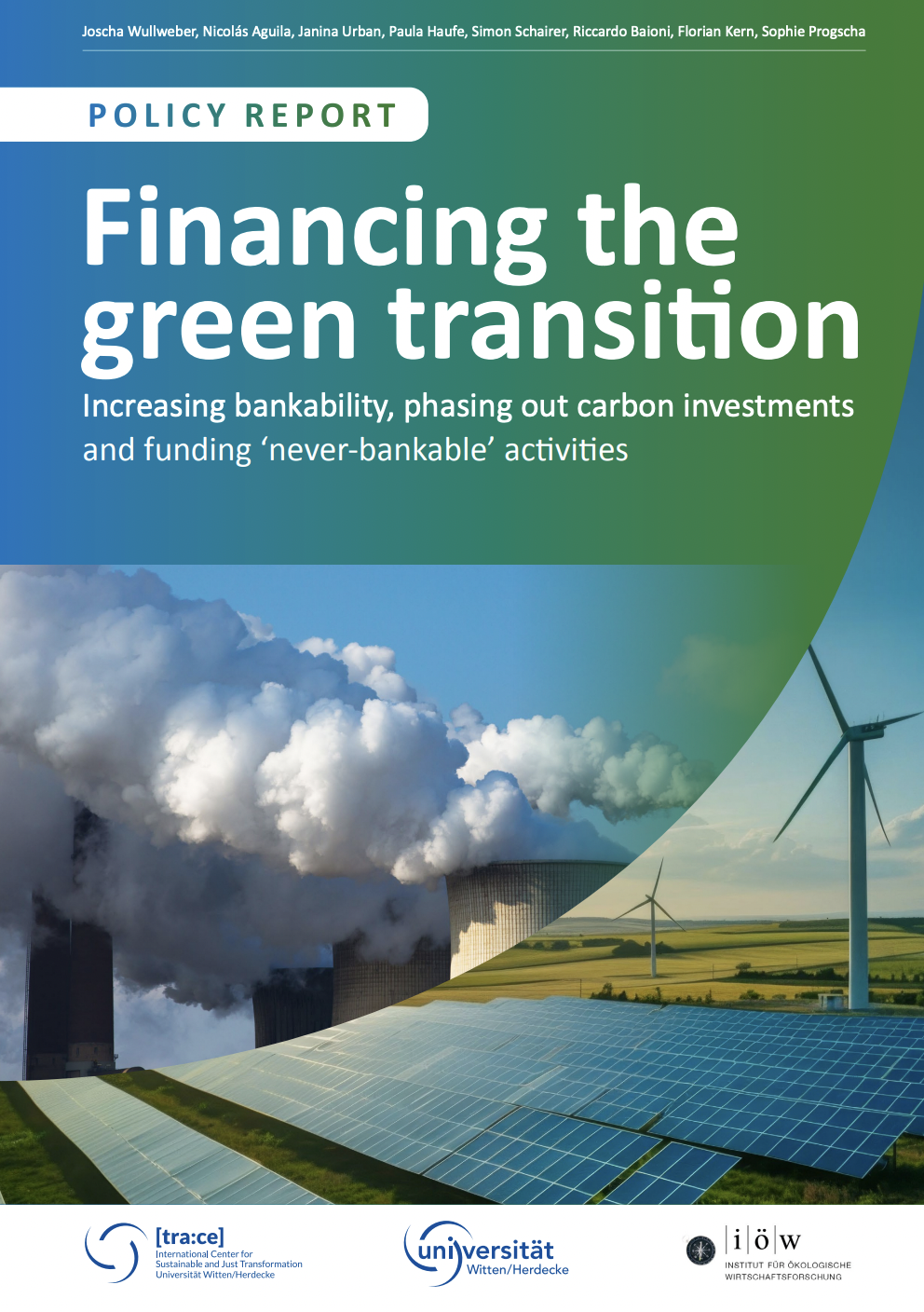
Financing the green transition: Increasing bankability, phasing out carbon investments and funding 'never-bankable' activities
Why does a large green financing gap persist despite intensified efforts in recent years to mobilize financial resources? What policy instruments and strategies could be used to steer financial flows from unsustainable to sustainable investments? Based on a mixed-methods approach, that combined document analysis of over 330 key documents and 88 semi-structured interviews, the policy report shows that the problem is not the lack of capital, but the lack of bankable green projects. Increases in green lending and investments by banks and other financial institutions remain negligible because green investments fail to meet the desired risk-return profiles of investors. In other words, many green firms and projects are considered as ‘non-bankable’. Based on our analysis, we propose a classification that considers two criteria: 1) Is the investment green or does it generate high GHG emissions? 2) Is it bankable, not yet bankable, or never bankable? This taxonomy forms the basis for the projects’ policy recommendations that can increase the bankability of not-yet bankable firms and projects, decrease the bankability of high-GHG emitting ones, and expand financing for never bankable activities
- Veröffentlichungsdatum: 26.06.2025
- Autor:innen: Joscha Wullweber, Nicolás Aguila, Janina Urban, Paula Haufe, Simon Schairer, Riccardo Baioni, Florian Kern, Sophie Progscha
- Publikationsart: Policy Report
- Keywords: Sustainable Finance, Green Transision, Financial Policies, Green Central Banking, Sustainable Transformation, Bankability, Decarbonisation, Green investment, Shadow carbon financing, Green Financing Gap
- Link zum PDF-Dokument
SuFi I Greener and cheaper: Green monetary policy in the era of inflation and high interest rates
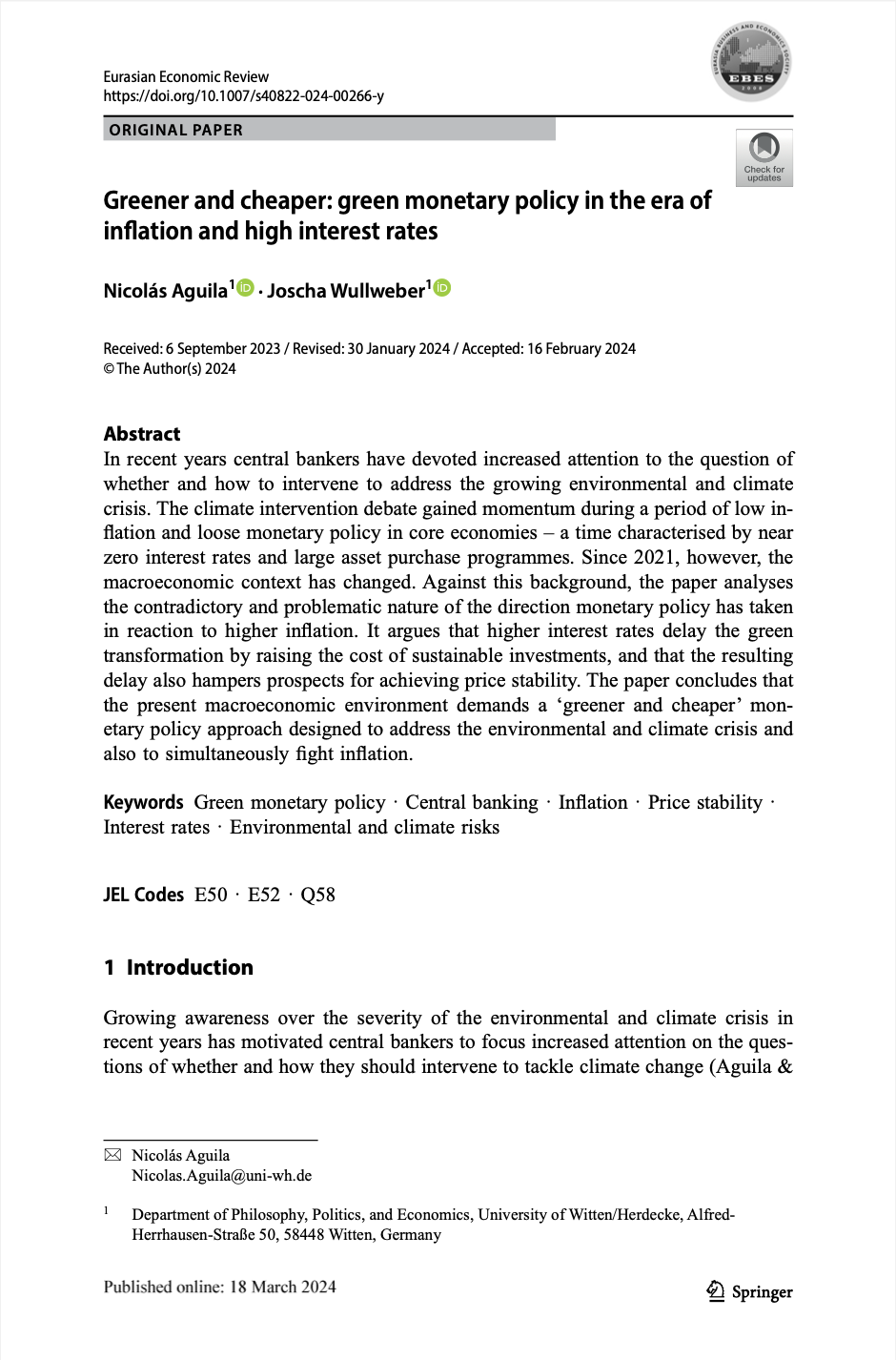
Greener and cheaper: Green monetary policy in the era of inflation and high interest rates
In recent years central bankers have devoted increased attention to the question of whether and how to intervene to address the growing environmental and climate crisis. The climate intervention debate gained momentum during a period of low inflation and loose monetary policy in core economies – a time characterised by near zero interest rates and large asset purchase programmes. Since 2021, however, the macroeconomic context has changed. Against this background, the paper analyses the contradictory and problematic nature of the direction monetary policy has taken in reaction to higher inflation. It argues that higher interest rates delay the green transformation by raising the cost of sustainable investments, and that the resulting delay also hampers prospects for achieving price stability. The paper concludes that the present macroeconomic environment demands a ‘greener and cheaper’ monetary policy approach designed to address the environmental and climate crisis and also to simultaneously fight inflation.
- Veröffentlichungsdatum: 18.03.2024
- Autor:innen: Nicolás Aguila & Joscha Wullweber
- Publikationsart: Paper
- Keywords: Green monetary policy, Central banking, Inflation, Price stability, Interest rates, Environmental and climate risks
- Link zum PDF-Dokument
SuFi I Legitimising green monetary policies: Market liberalism, layered central banking, and the ECB’s ongoing discursive shift from environmental risks to price stability
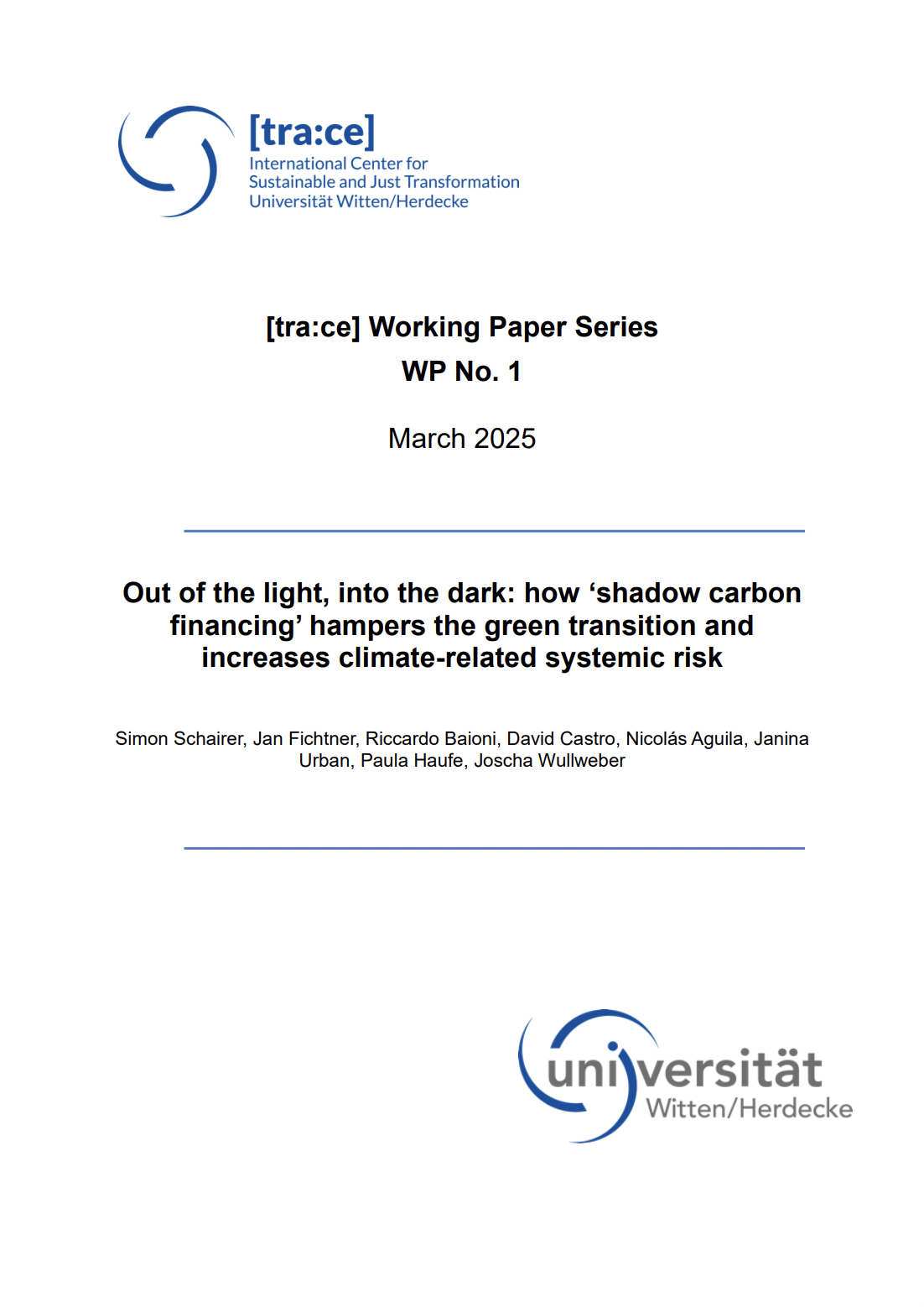
Out of the light, into the dark: how ‘shadow carbon financing’ hampers the green transition and increases climate-related systemic risk
Recent years saw major regulatory efforts to steer the financial system towards financing the transition to a net-zero carbon economy and phase out carbon financing. However, EU regulation focuses primarily on preventing greenwashing of retail funds and decarbonizing the banking system, while leaving the nexus of offshore finance and the shadow banking system untouched. These blind spots seriously undermine regulatory efficacy because offshore finance enables the obfuscation of financial flows, while shadow banking facilitates alternative financing to high carbon-emitting firms. Drawing on qualitative expert interviews and financial market data, the paper explains how the offshore-shadow-banking nexus hampers the green transition by introducing the concept of 'shadow carbon financing', which can operate through the following channels: (1) loan securitization, (2) emissions risk transfers, (3) bond financing, (4) carbon asset partitioning, (5) offshore corporate wealth chains, (6) private credit, and (7) proved developed producing reserves securitization. We demonstrate several instances of financial flows moving away from regulated and transparent forms of financing to less regulated and more opaque shadow carbon financing channels. Consequently, we argue that shadow carbon financing may also pose substantial systemic risk, as climate-related risks (e.g., stranded assets) increasingly accumulate in less regulated parts of the financial system.
- Veröffentlichungsdatum: 28.03.2025
- Autor:innen: Simon Schairer, Jan Fichtner, Riccardo Baioni, David Castro, Nicolás Aguila, Janina Urban, Paula Haufe, Joscha Wullweber
- Publikationsart: Working Paper
- Keywords: sustainable finance, offshore finance, shadow banking, green transition, climate-related risks, systemic risk
- Link zum PDF-Dokument
SuFi I Out of the light, into the dark: how ‘shadow carbon financing’ hampers the green transition and increases climate-related systemic risk
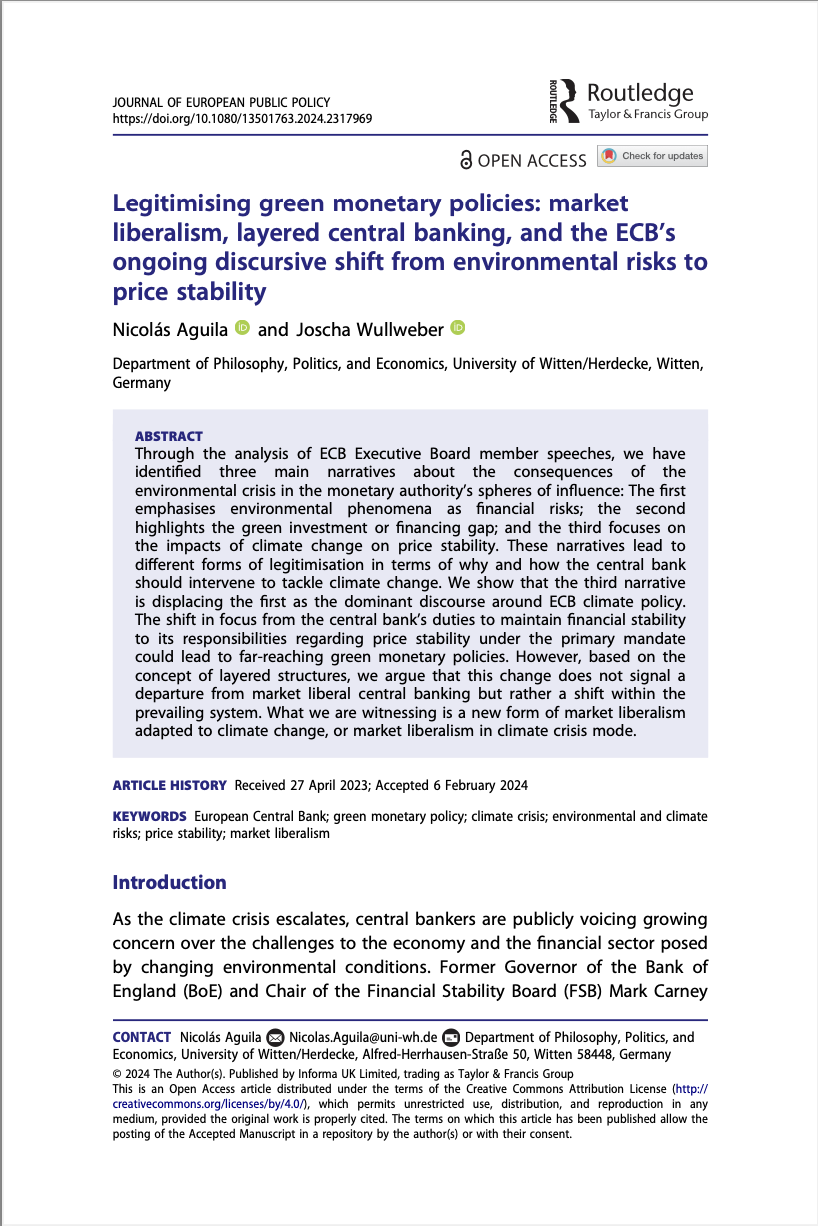
Playing the capital market? Sustainable finance and the discursive construction of the Capital Markets Union as a common good
The Capital Markets Union (CMU) project aims to create more integrated capital markets in Europe. However, the project faces resistance, and despite ongoing efforts EU capital markets remain fragmented. Based on an analysis of European Commission documents and ECB speeches, the paper identifies and conceptualises a set of discursive strategies employed to relegitimise the stalling CMU project and mobilise market-based finance for green investments. We distinguish two periods. First, the Commission used discursive strategies to introduce sustainable finance into the EU agenda, strategically framing it ‘as part of’ the CMU project. The strategies aimed to attract private finance, restore trust in market-based finance and reassure that the competitiveness of European industry would not be endangered by sustainability-related regulations. Second, since the launch of the European Green Deal and amid slow progress on the CMU, the Commission and ECB have constructed the CMU as key to financing the green transition and, more recently, other common goods. The analysis sheds light on the political dimension of this strategy by showing it primarily addresses the demands of certain fractions of the financial industry and, to a certain extent, of some environmental civil society organisations, while critical objections regarding market-based finance remain largely unacknowledged.
- Veröffentlichungsdatum: 17.02.2024
- Autor:innen: Nicolás Aguila & Joscha Wullweber
- Publikationsart: Article
- Keywords: European Central Bank; green monetary policy,
- Link zum PDF-Dokument
SuFi I Playing the capital market? Sustainable finance and the discursive construction of the Capital Markets Union as a common good
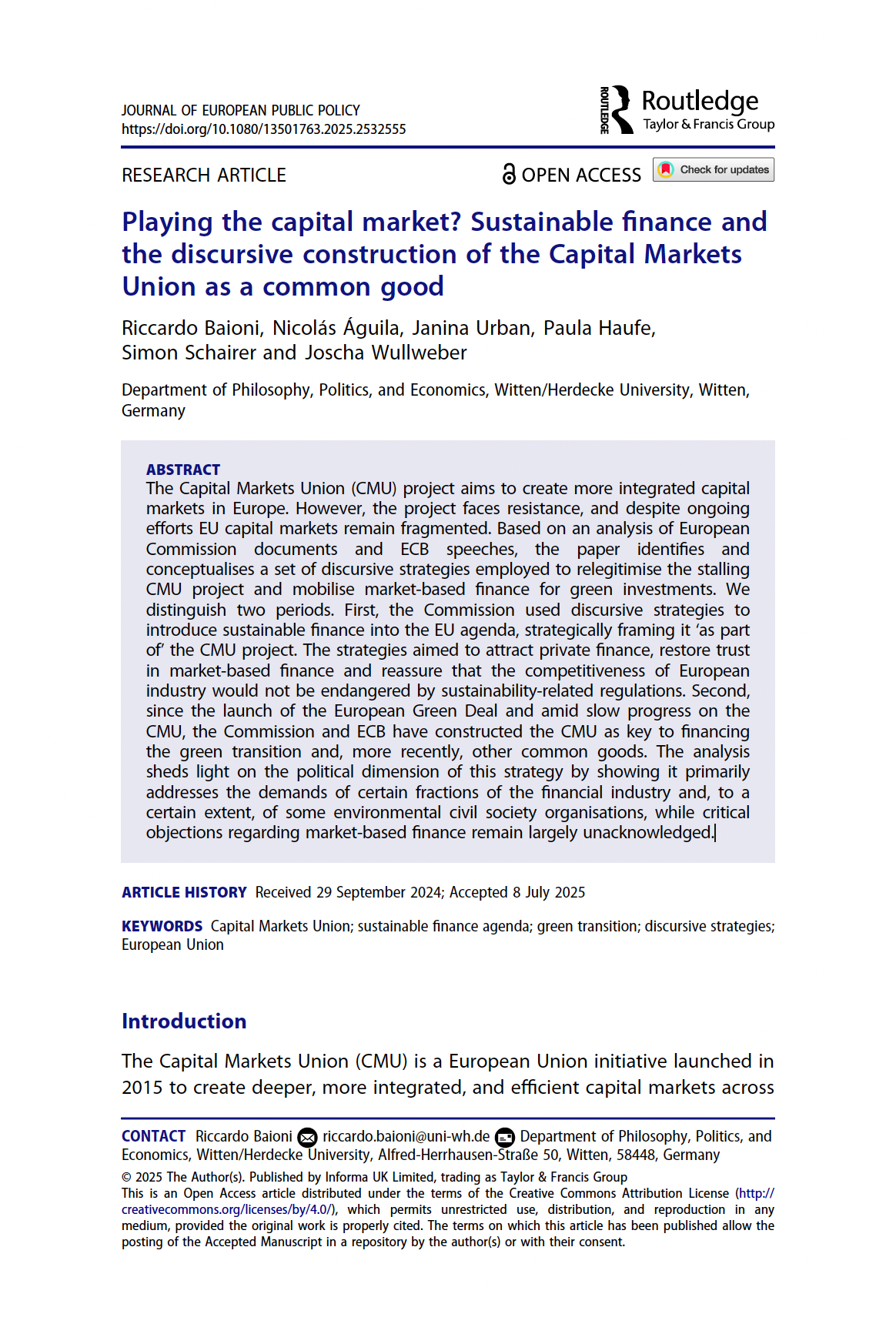
Playing the capital market? Sustainable finance and the discursive construction of the Capital Markets Union as a common good
The Capital Markets Union (CMU) project aims to create more integrated capital markets in Europe. However, the project faces resistance, and despite ongoing efforts EU capital markets remain fragmented. Based on an analysis of European Commission documents and ECB speeches, the paper identifies and conceptualises a set of discursive strategies employed to relegitimise the stalling CMU project and mobilise market-based finance for green investments. We distinguish two periods. First, the Commission used discursive strategies to introduce sustainable finance into the EU agenda, strategically framing it ‘as part of’ the CMU project. The strategies aimed to attract private finance, restore trust in market-based finance and reassure that the competitiveness of European industry would not be endangered by sustainability-related regulations. Second, since the launch of the European Green Deal and amid slow progress on the CMU, the Commission and ECB have constructed the CMU as key to financing the green transition and, more recently, other common goods. The analysis sheds light on the political dimension of this strategy by showing it primarily addresses the demands of certain fractions of the financial industry and, to a certain extent, of some environmental civil society organisations, while critical objections regarding market-based finance remain largely unacknowledged.
- Veröffentlichungsdatum: 08.07.2025
- Autor:innen: Riccardo Baioni, Nicolás Águila, Janina Urban, Paula Haufe, Simon Schairer and Joscha Wullweber
- Publikationsart: Article
- Keywords: Capital Markets Union; sustainable finance agenda; green transition; discursive strategies; European Union
- Link zum PDF-Dokument
SuFi I The ecor as global special purpose money: towards a green international monetary system to finance sustainable and just transformation
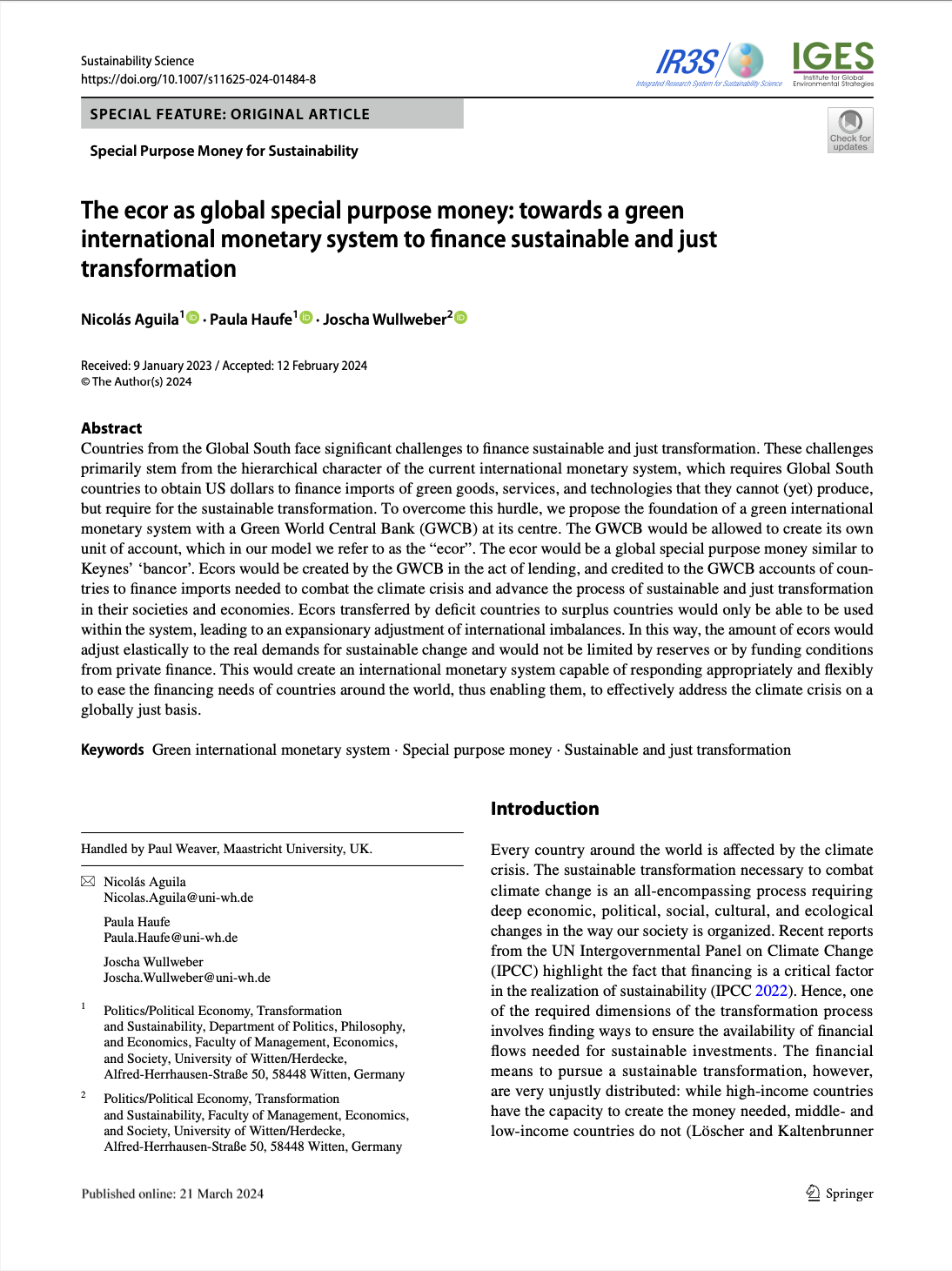
The ecor as global special purpose money: towards a green international monetary system to finance sustainable and just transformation
Countries from the Global South face signifcant challenges to fnance sustainable and just transformation. These challenges primarily stem from the hierarchical character of the current international monetary system, which requires Global South countries to obtain US dollars to fnance imports of green goods, services, and technologies that they cannot (yet) produce, but require for the sustainable transformation. To overcome this hurdle, we propose the foundation of a green international monetary system with a Green World Central Bank (GWCB) at its centre. The GWCB would be allowed to create its own unit of account, which in our model we refer to as the “ecor”. The ecor would be a global special purpose money similar to Keynes’ ‘bancor’. Ecors would be created by the GWCB in the act of lending, and credited to the GWCB accounts of countries to fnance imports needed to combat the climate crisis and advance the process of sustainable and just transformation in their societies and economies. Ecors transferred by defcit countries to surplus countries would only be able to be used within the system, leading to an expansionary adjustment of international imbalances. In this way, the amount of ecors would adjust elastically to the real demands for sustainable change and would not be limited by reserves or by funding conditions from private fnance. This would create an international monetary system capable of responding appropriately and fexibly to ease the fnancing needs of countries around the world, thus enabling them, to efectively address the climate crisis on a globally just basis.
- Veröffentlichungsdatum: 21.03.2024
- Autor:innen: Nicolás Aguila, Paula Haufe & Joscha Wullweber
- Publikationsart: Article
- Keywords: Green international monetary system I Special purpose money I Sustainable and just transformation
- Link zum PDF-Dokument
SuFi I The green banking gap: how bankability, business models, and regulations challenge banks’ decarbonisation

The green banking gap: how bankability, business models, and regulations challenge banks’ decarbonisation
Banks have been slow to increase green lending while they continue to finance high-GHG-emitting activities, a phenomenon we call the "green banking gap". Based on interviews with 21 bank employees, supported by interviews with 67 practitioners working for non-bank financial institutions, the public sector, and civil society organisations in areas related to sustainable finance, we argue that explanations for the green banking gap can be grouped into three broad categories: bankability, business model, and regulation. First, there are not many green firms and projects that meet banks' desired risk/return profile, while high-GHG-emitting activities remain bankable. Second, there are constraints to decarbonise banks' portfolios arising from the significant change in their business model in recent decades, making (green) corporate, and particularly project, lending relatively less important. Even when they lend, the characteristics of the lending process imply a bias towards high-GHG-emitting over green activities as balance sheets are locked in old loans and banks prioritise long-term relationships with their clients. Finally, there are constraints on green lending and incentives to high-GHG-emitting lending arising from financial (liquidity and capital requirements) and sustainability regulations and overall policy uncertainty over the future decarbonisation path of the economy.
- Veröffentlichungsdatum: 07.05.2025
- Autor:innen: Nicolás Aguila, Paula Haufe, Riccardo Baioni, Jan Fichtner, Janina Urban, Simon Schairer und Joscha Wullweber
- Publikationsart: Working Paper
- Keywords: banks, green financing gap, climate-related and environmental risks, bankability, sustainable finance
- Link zum PDF-Dokument
